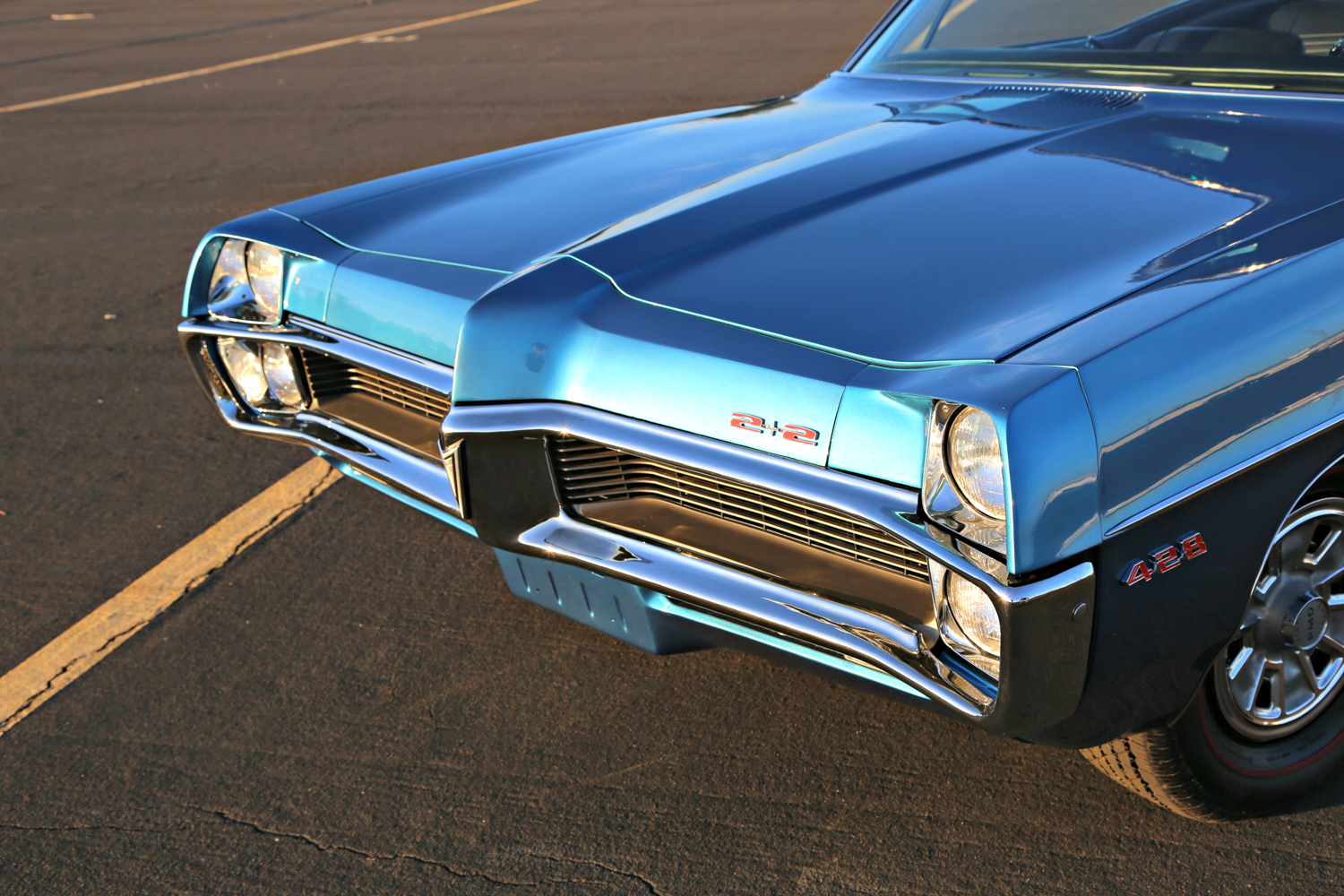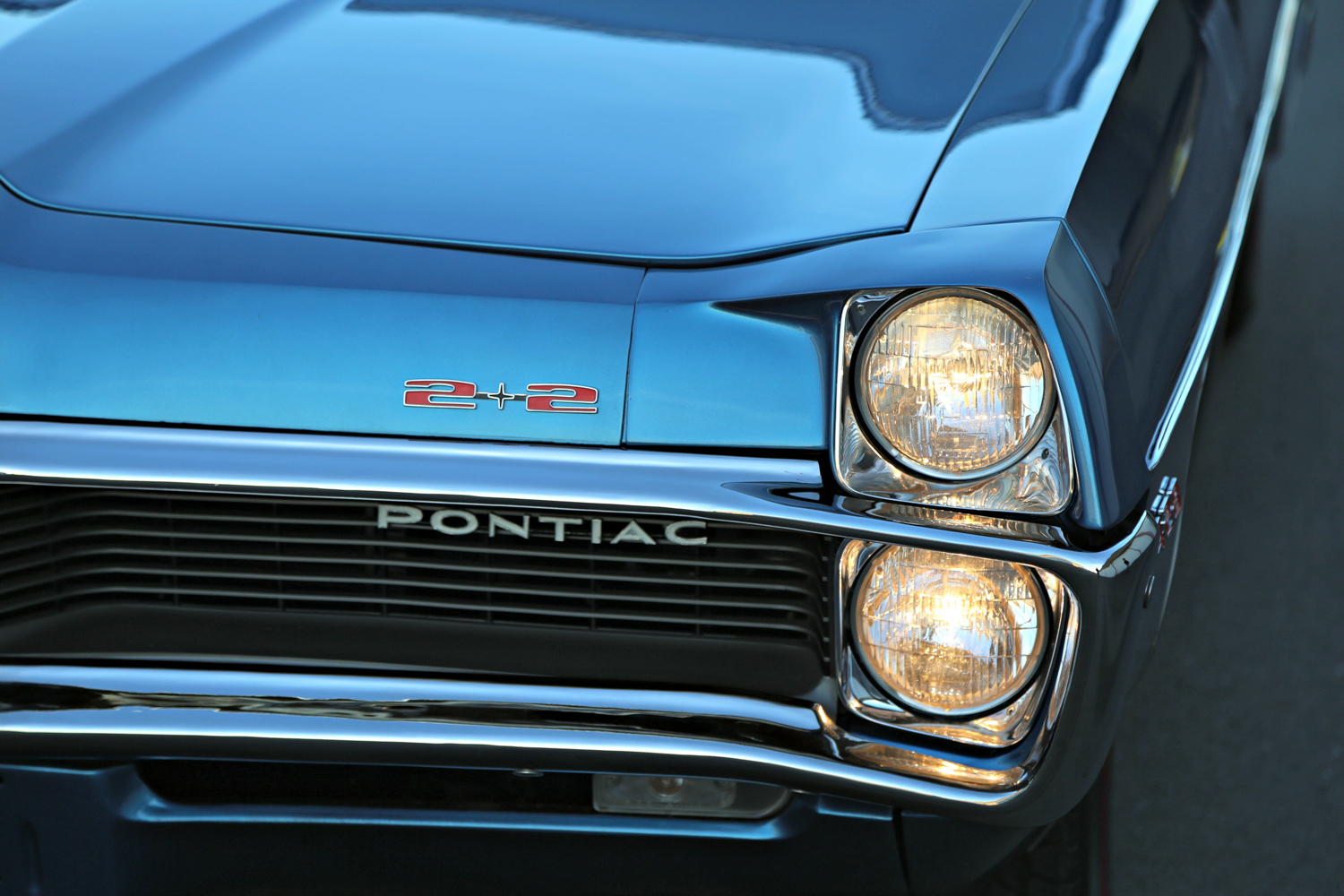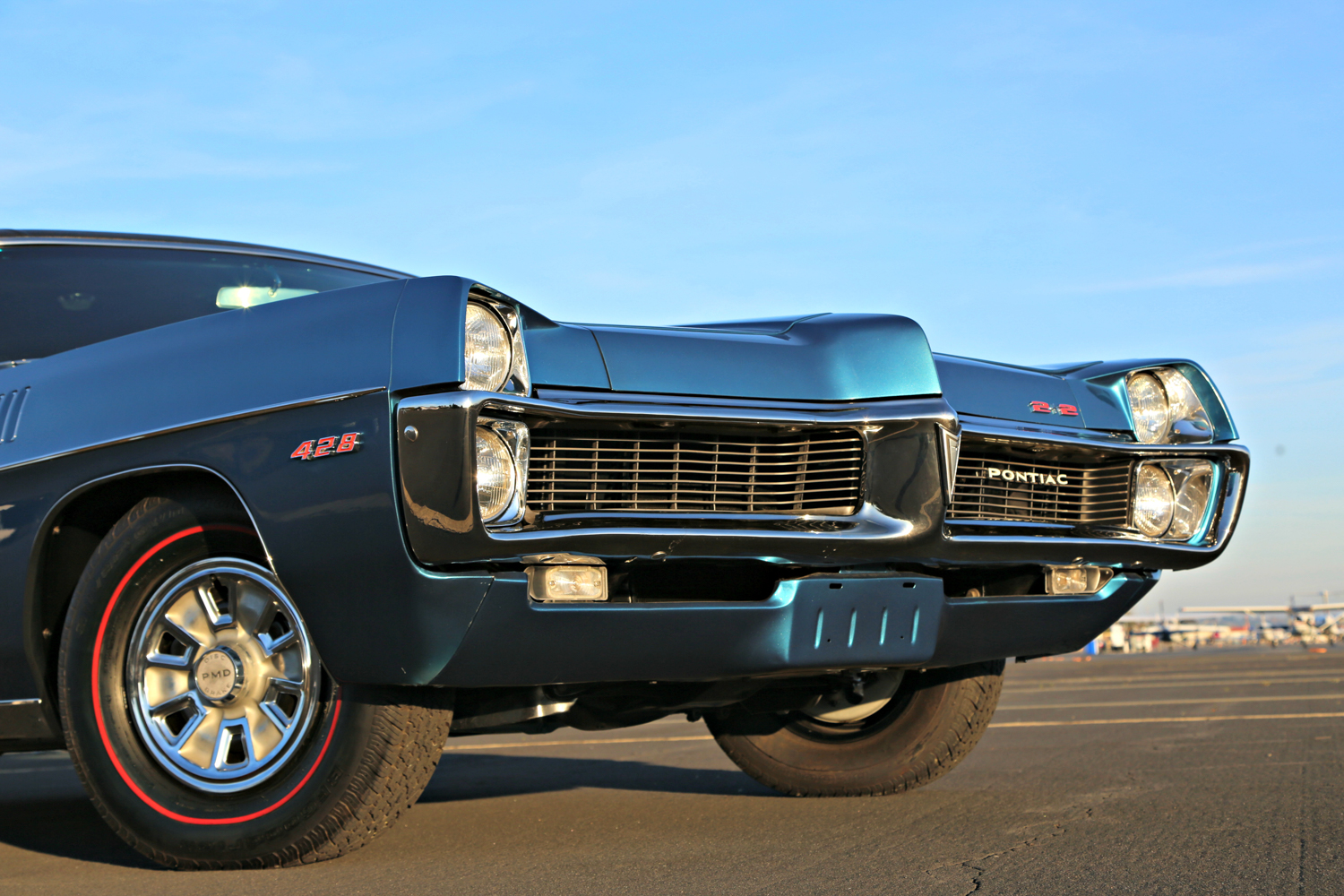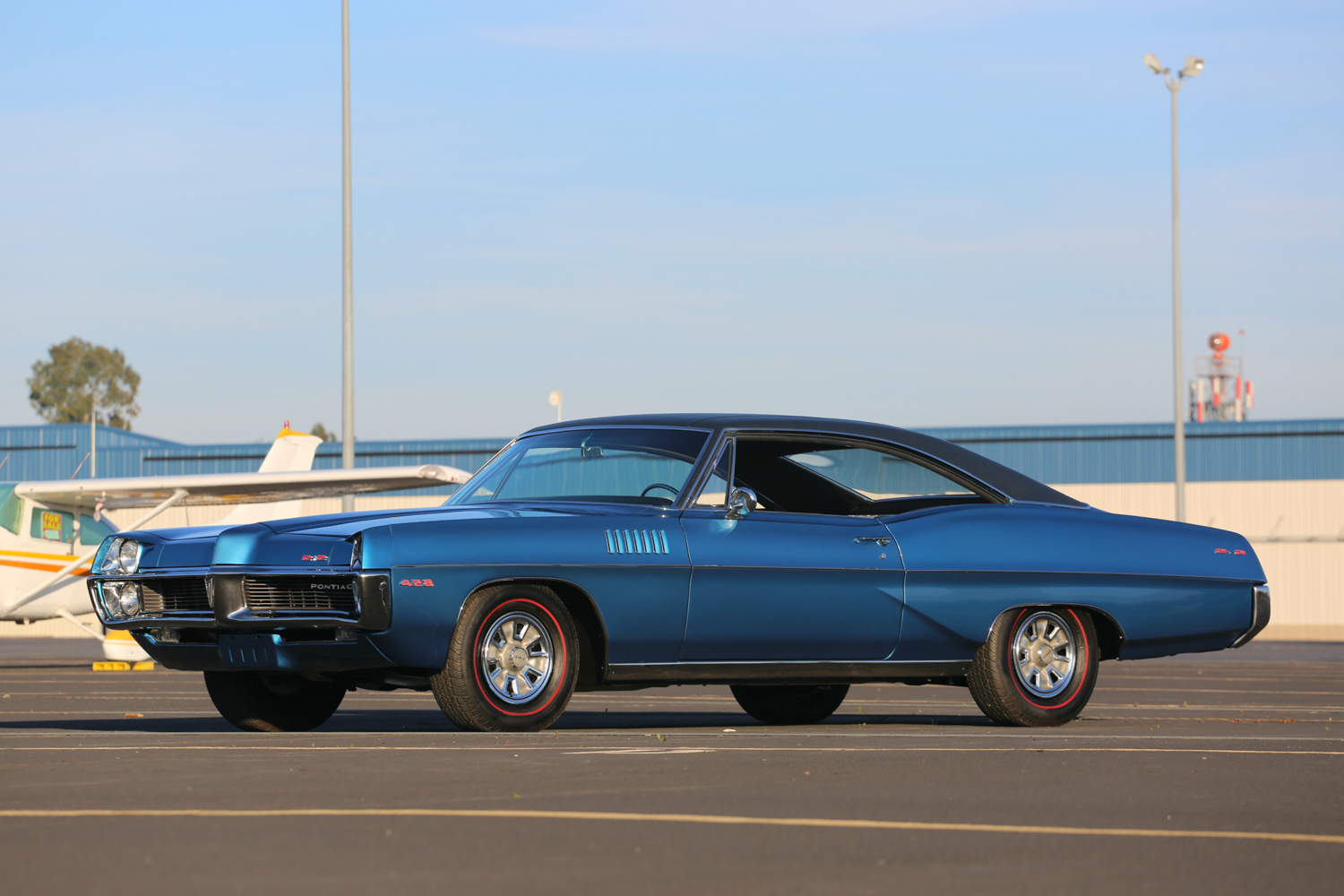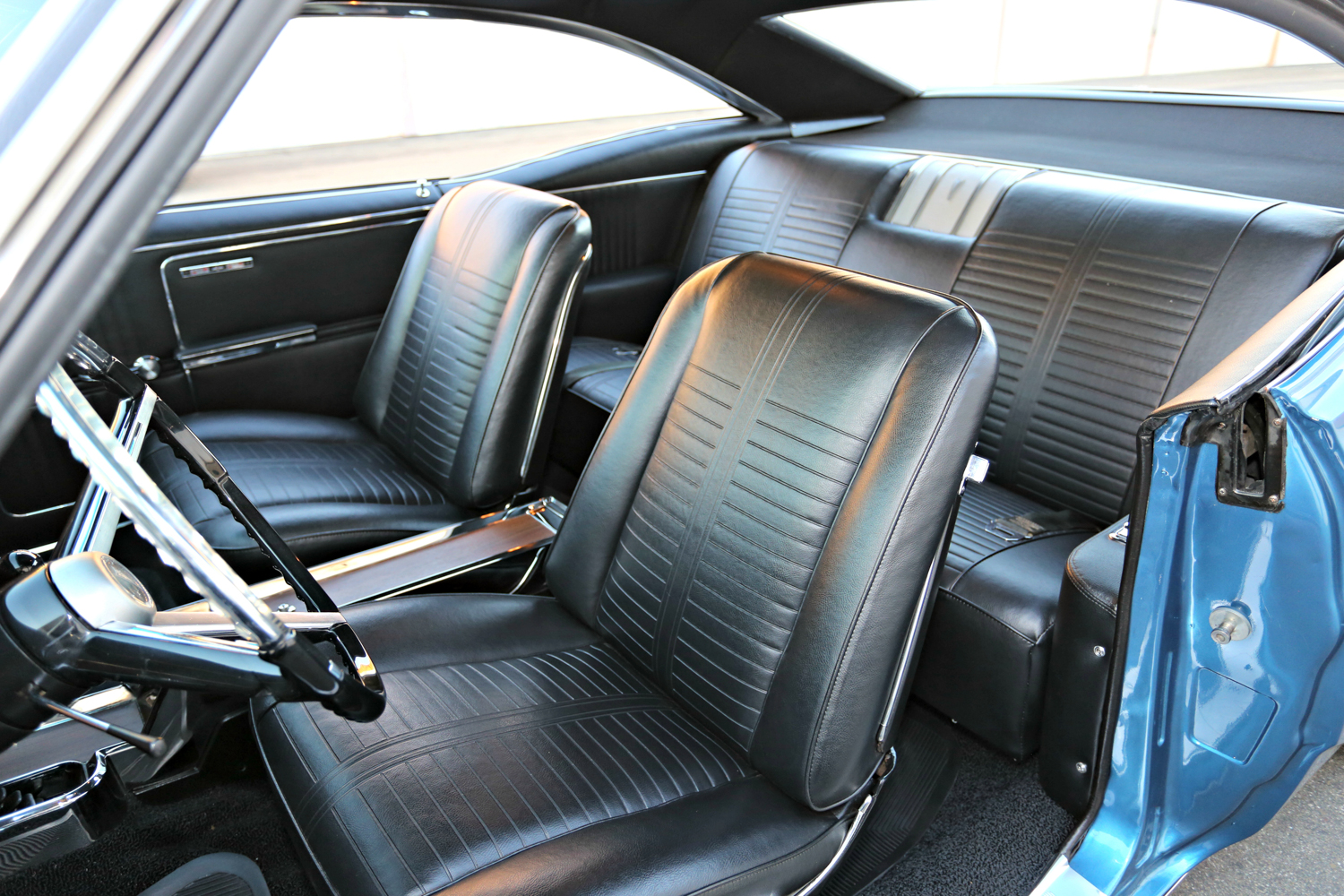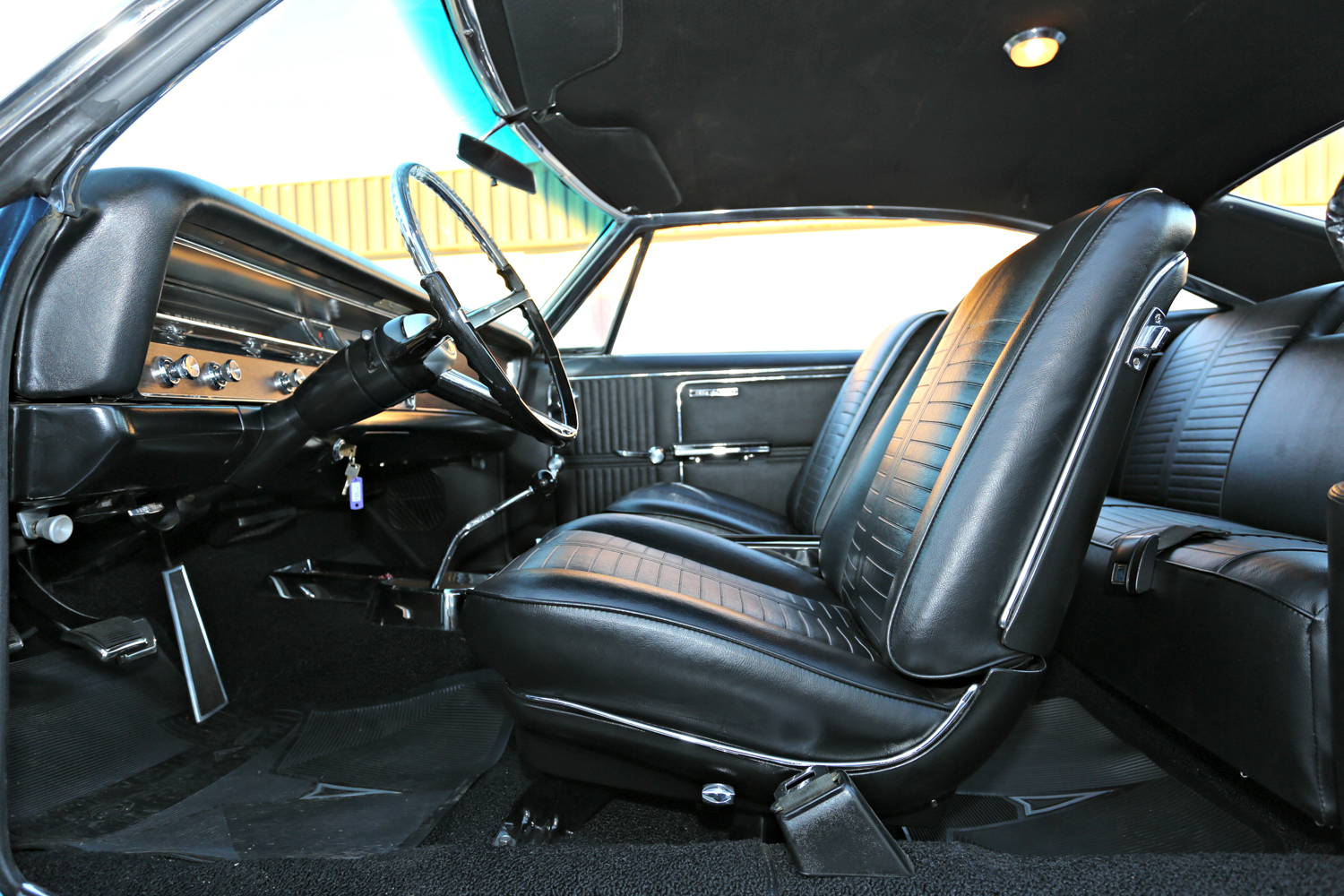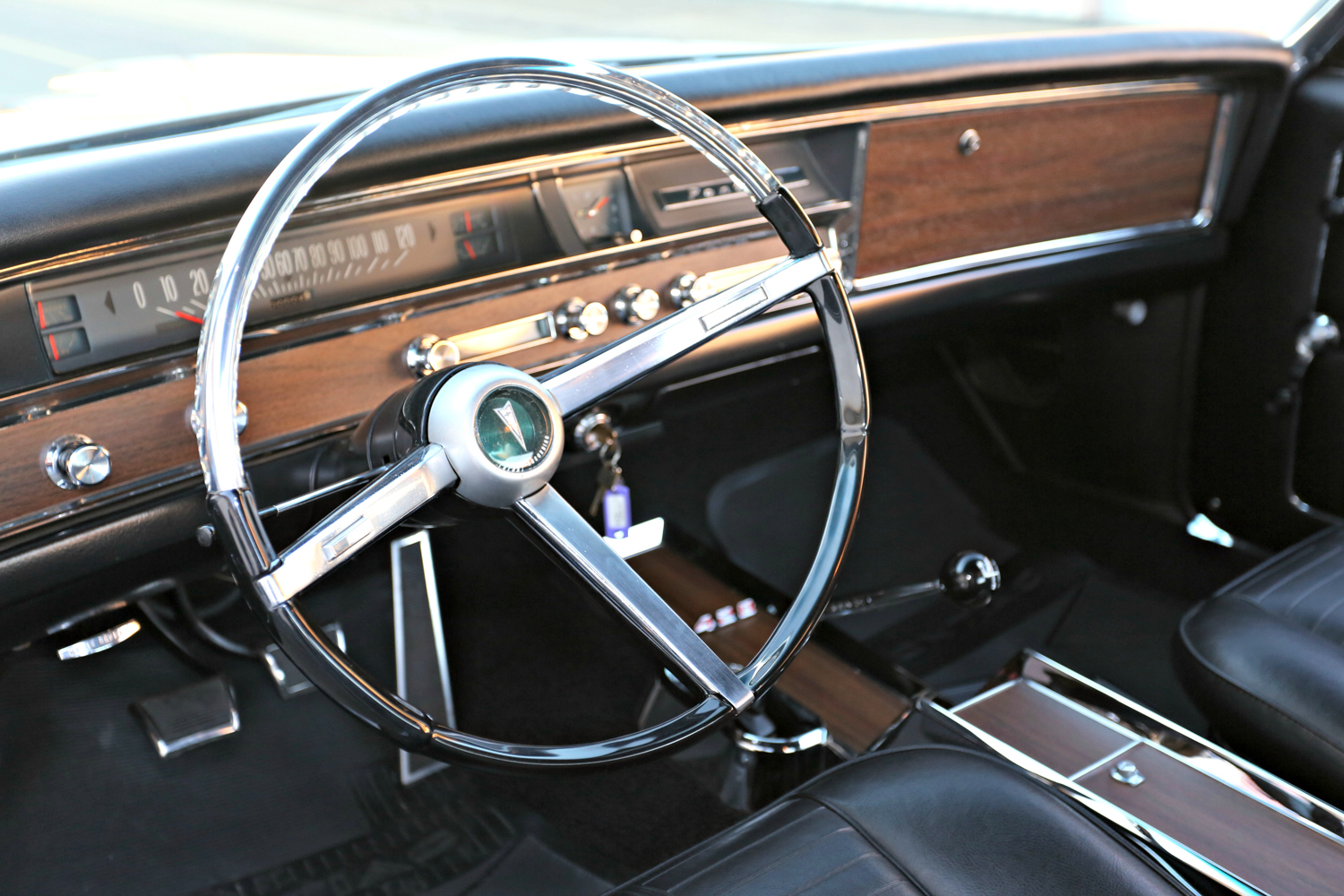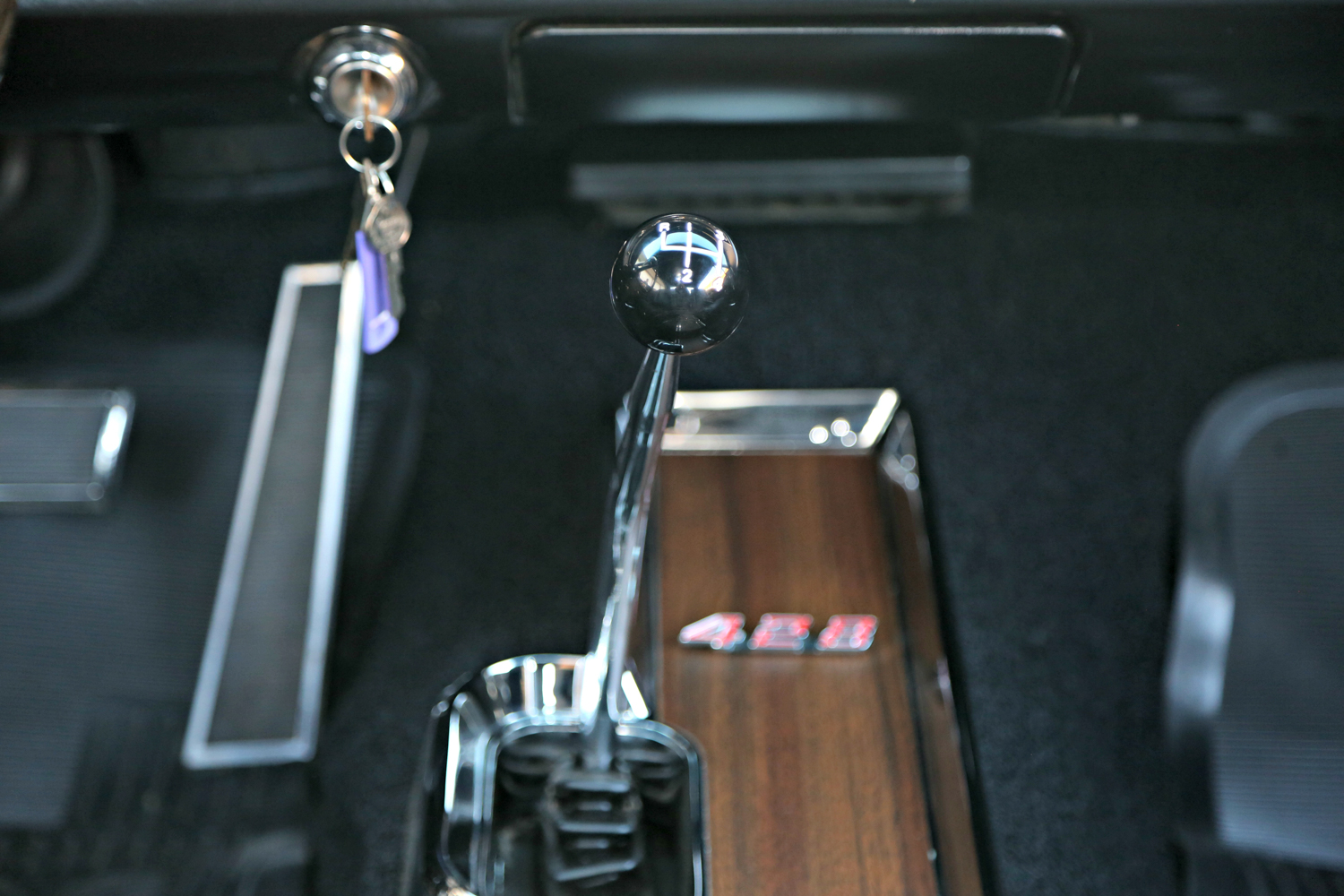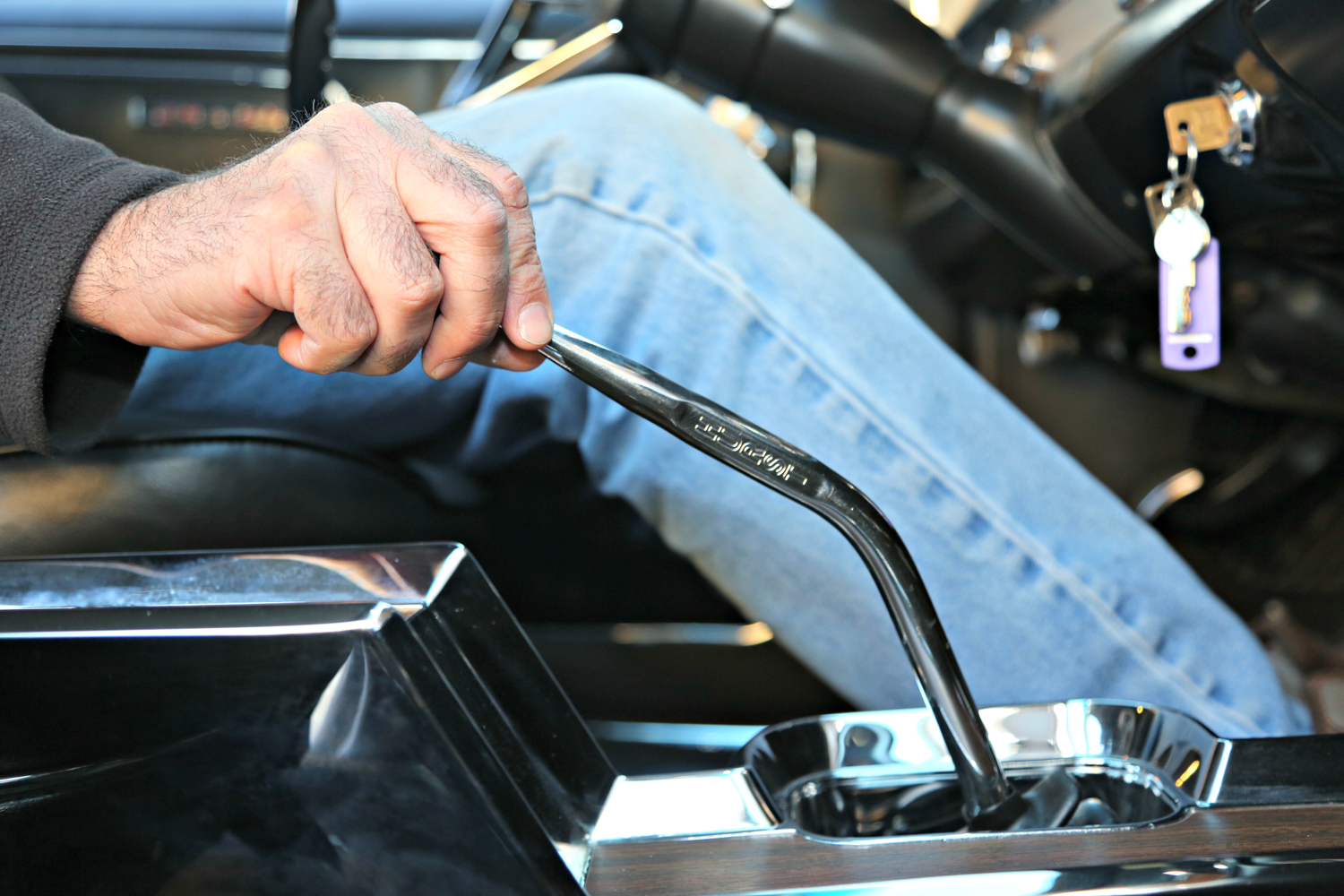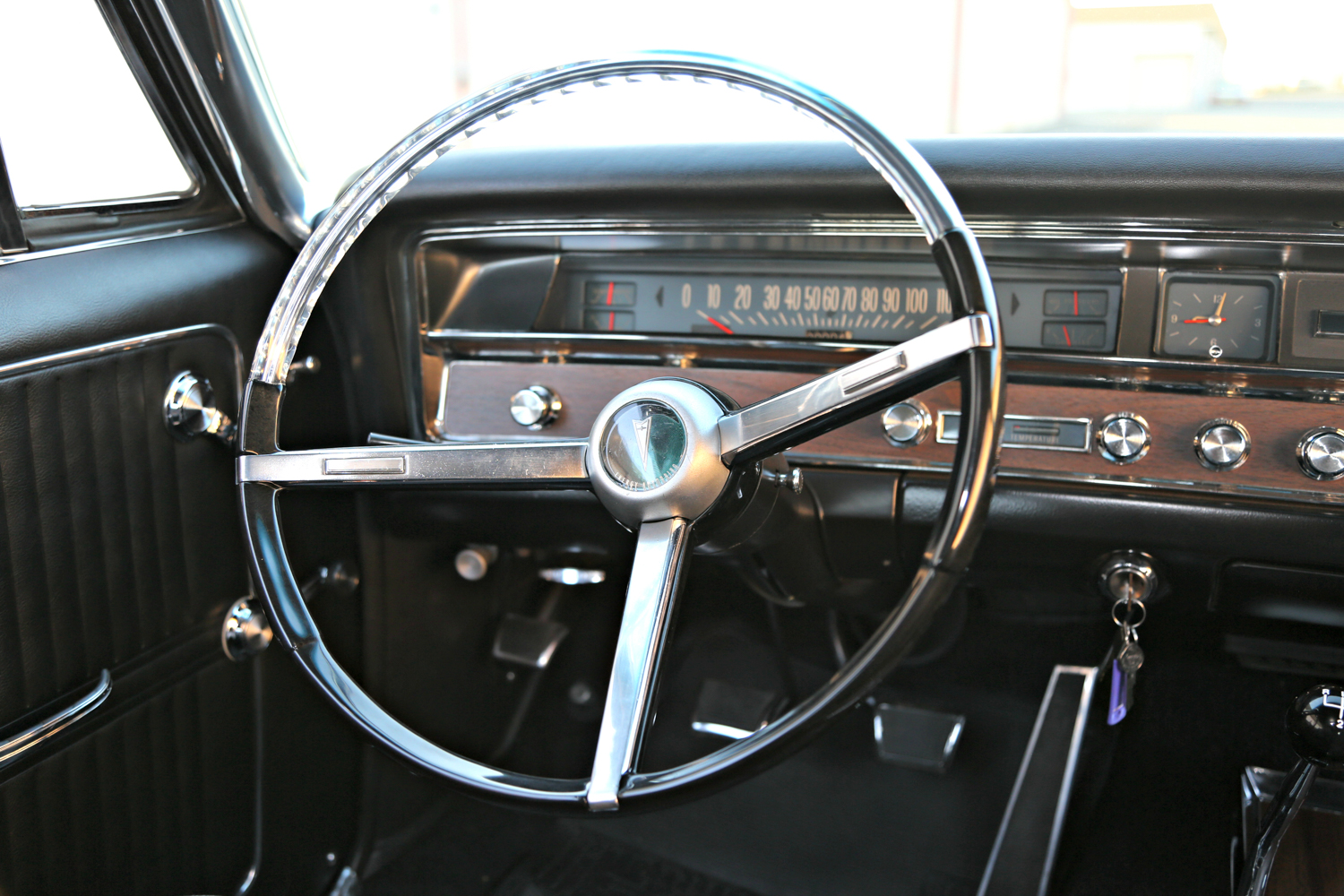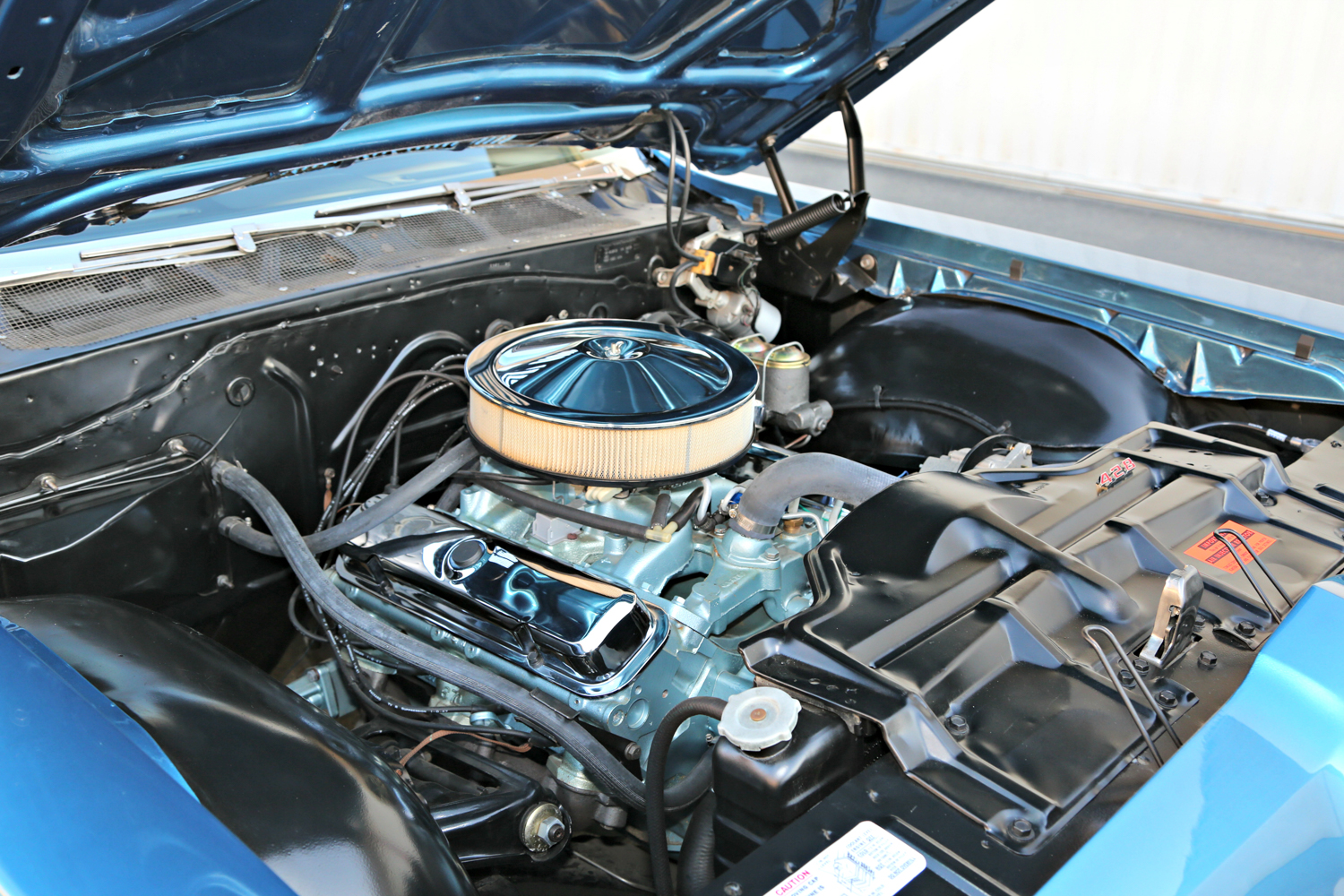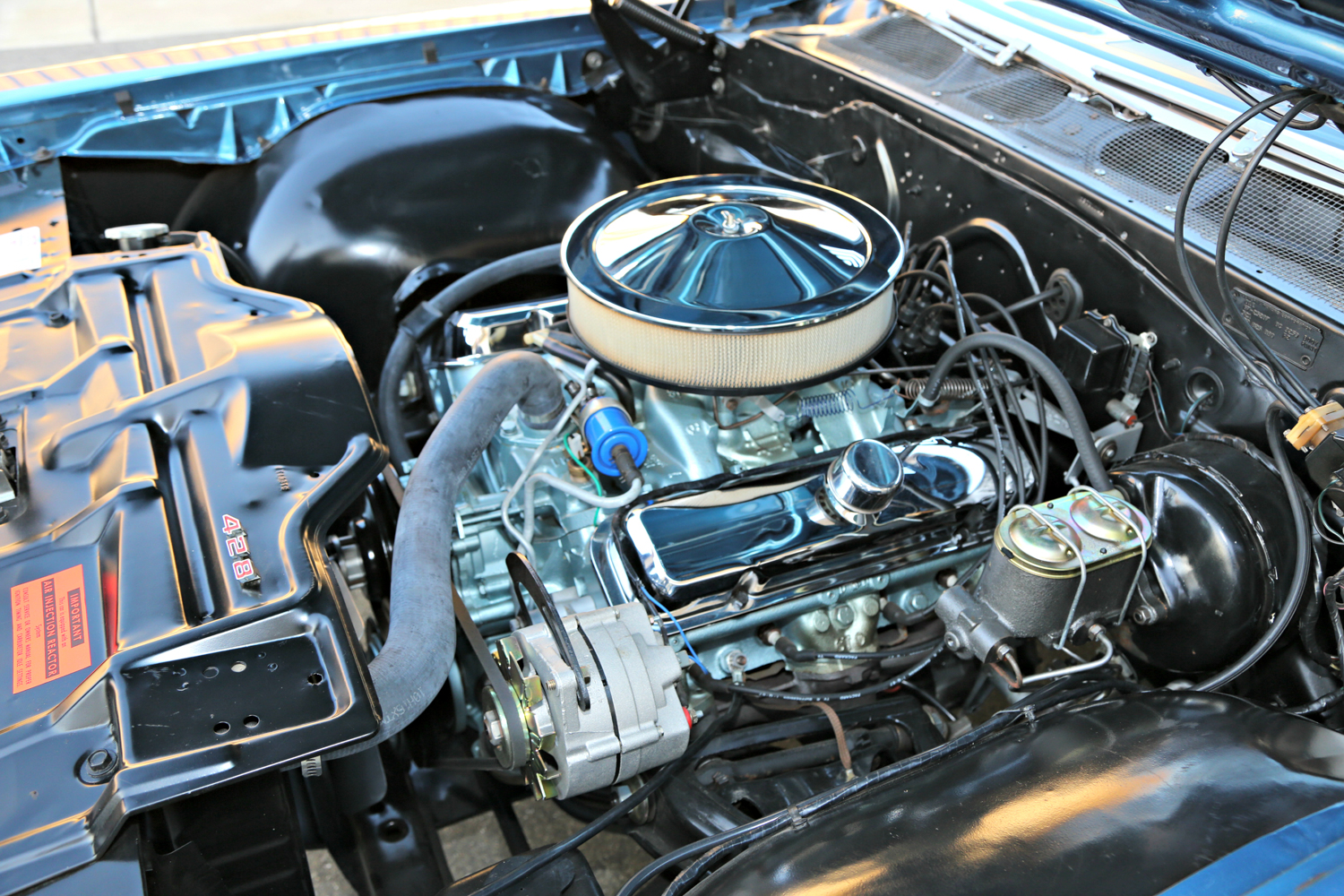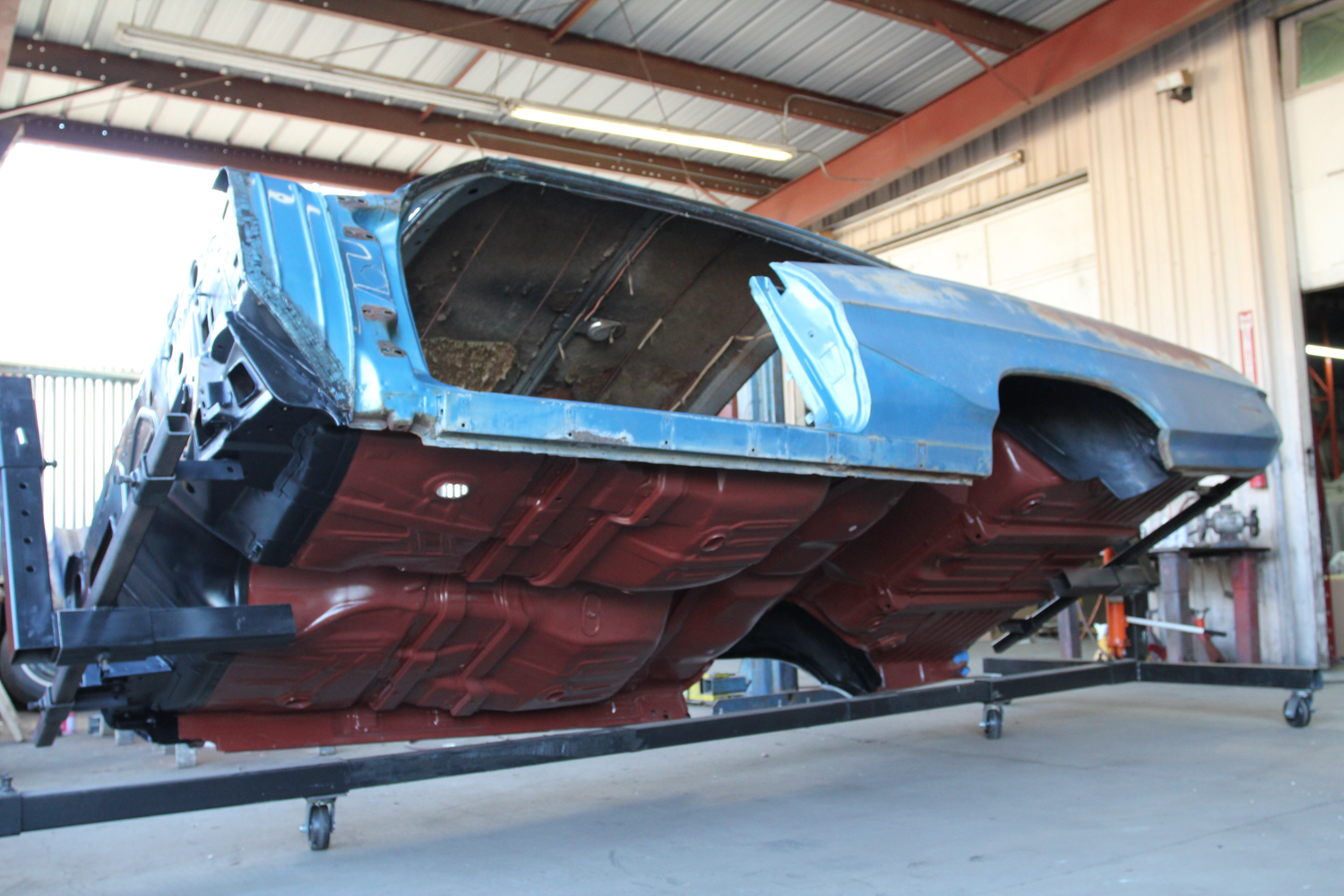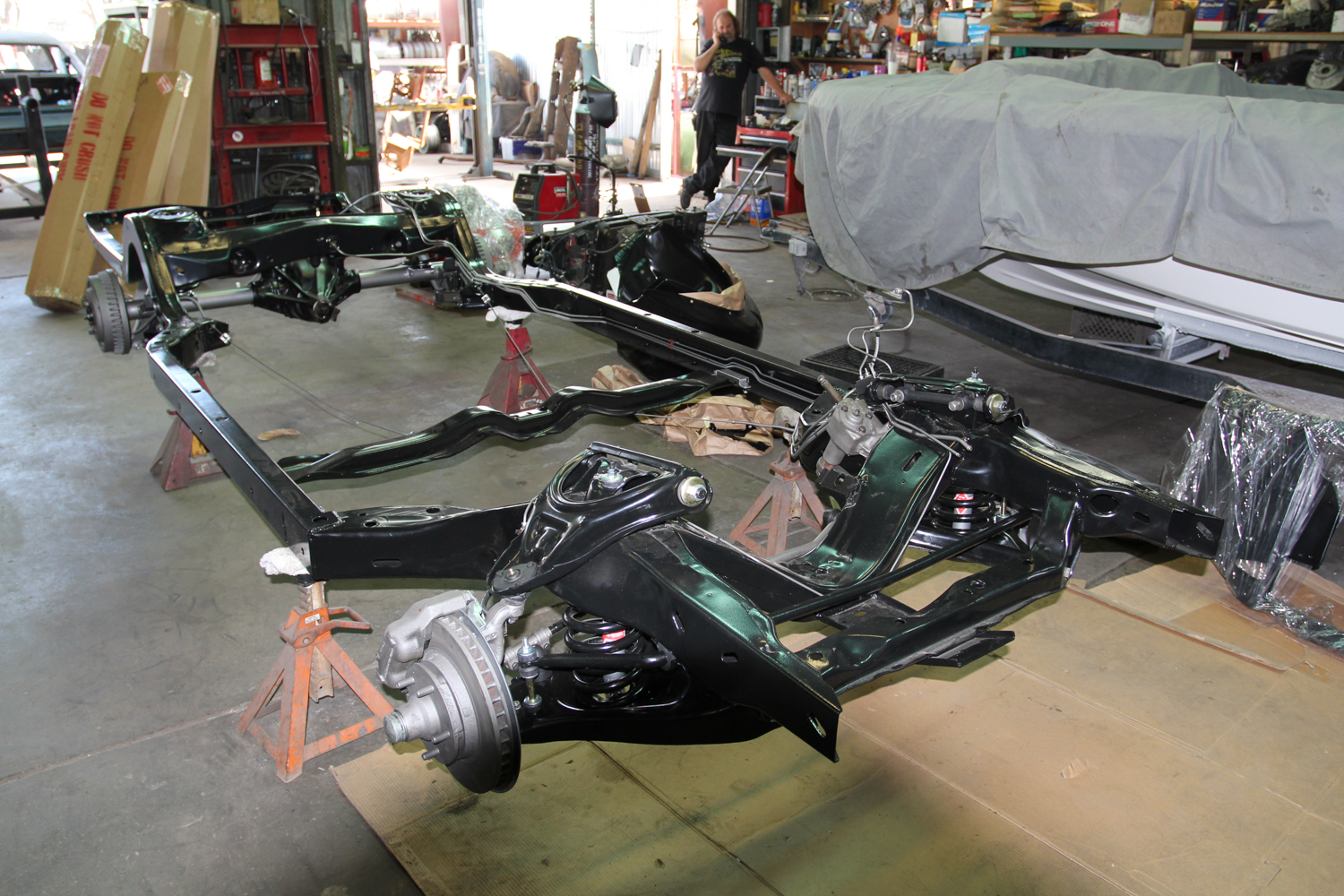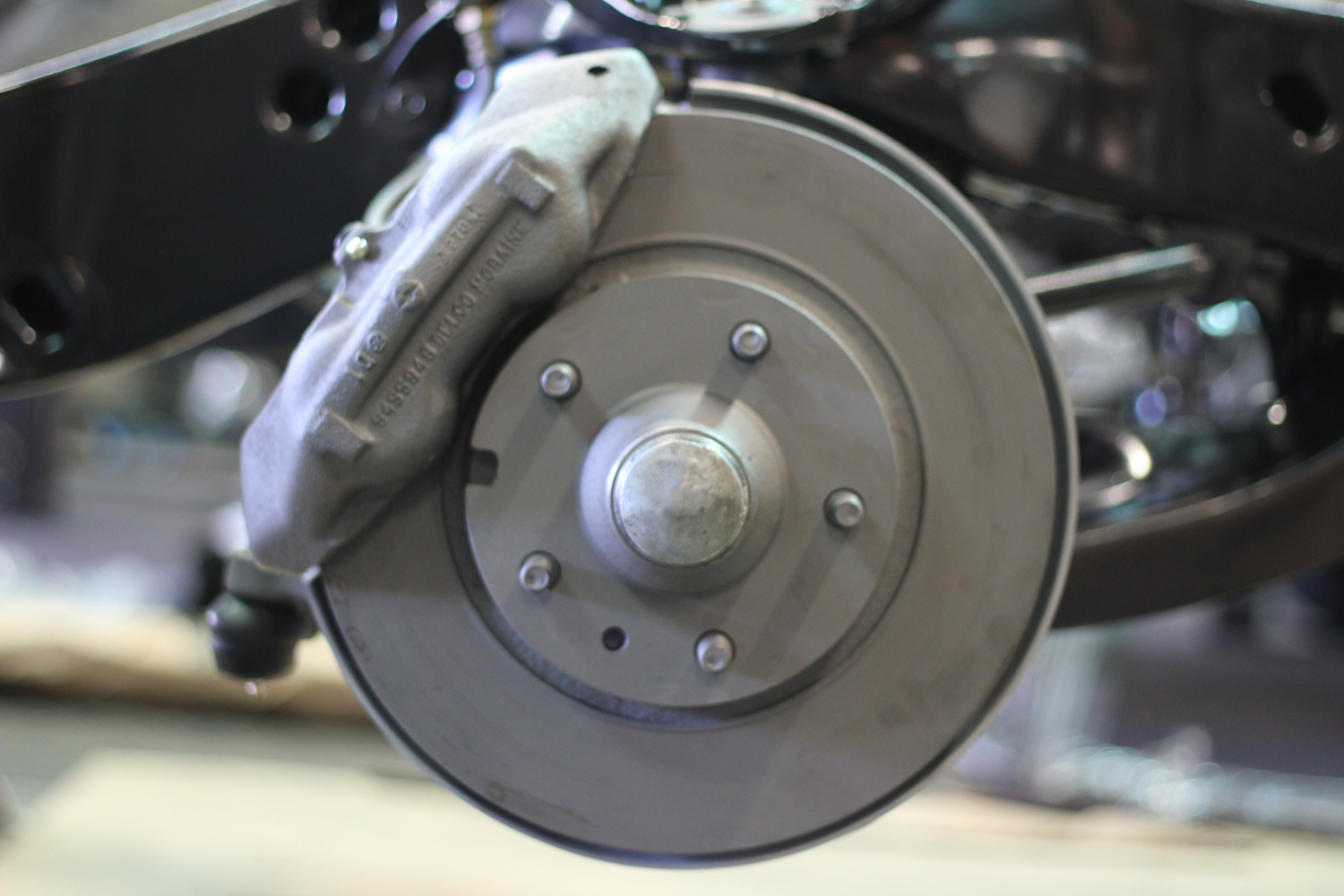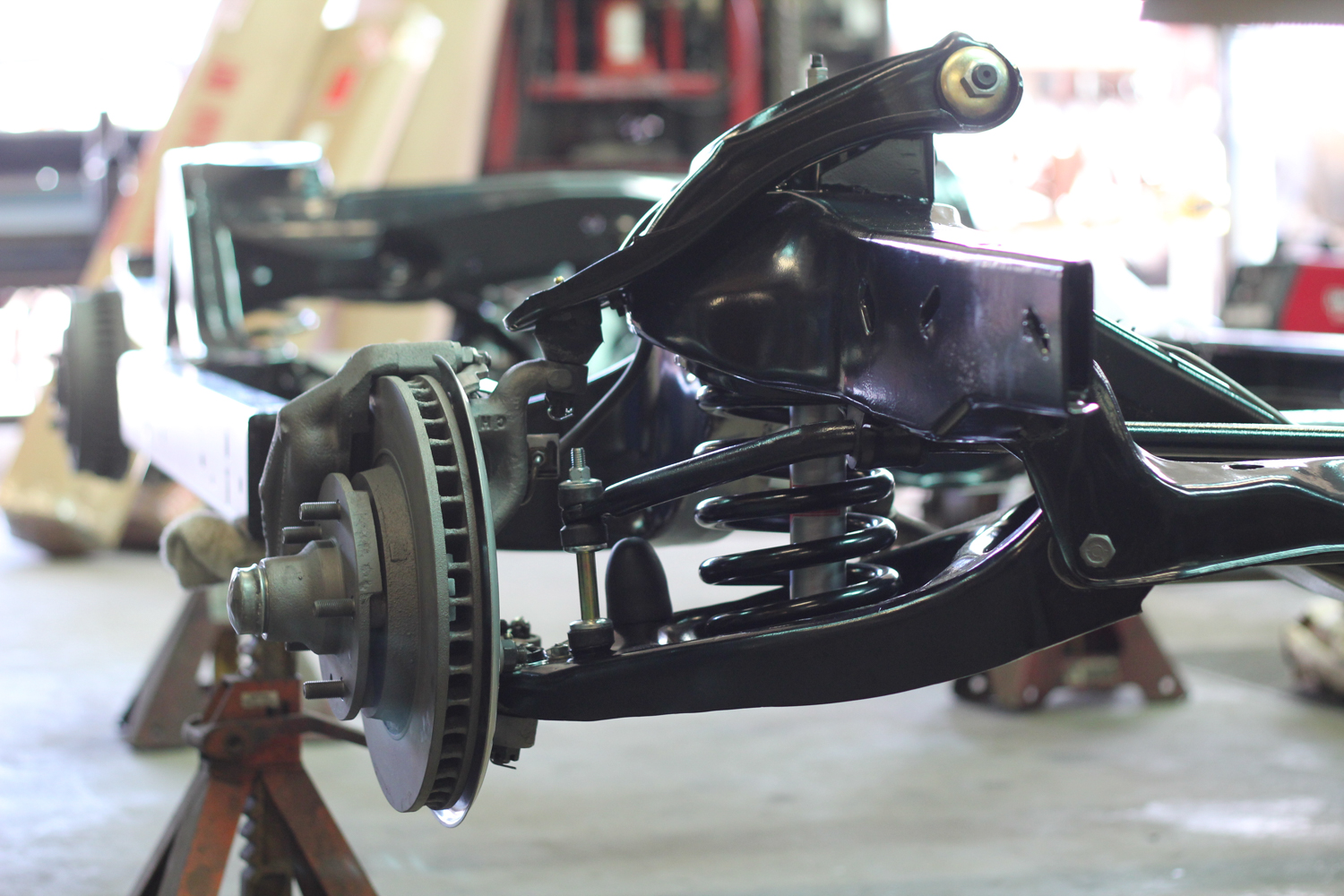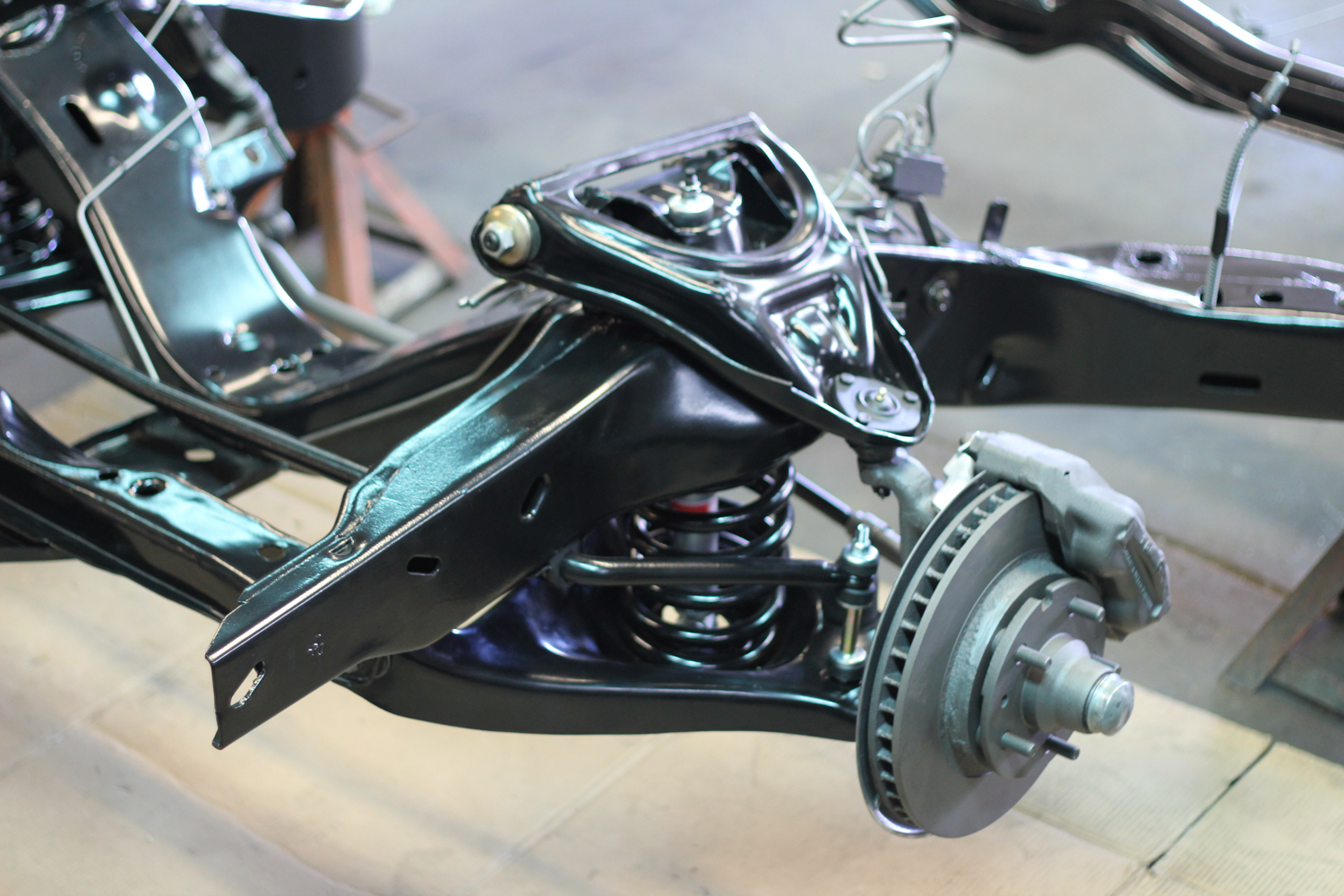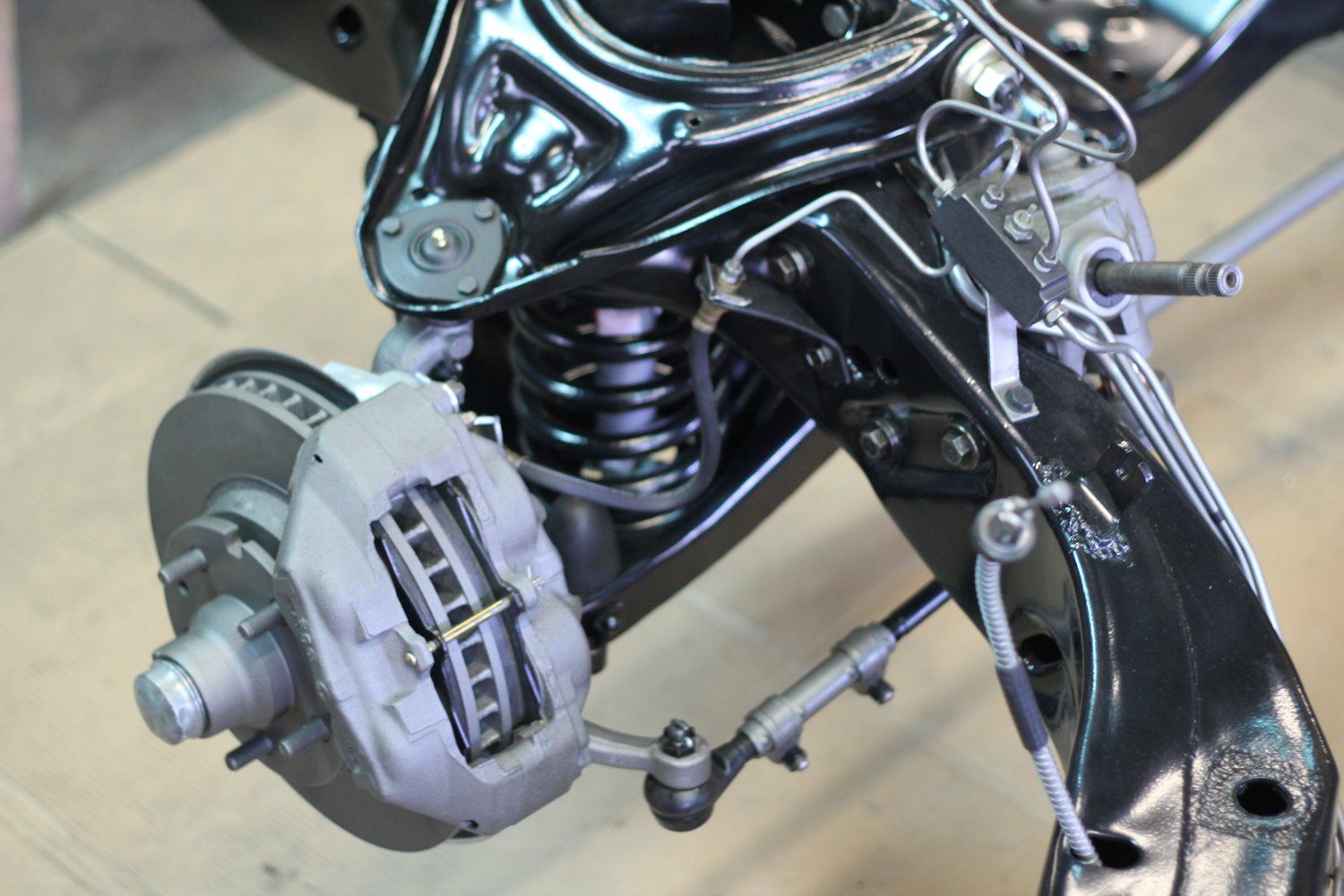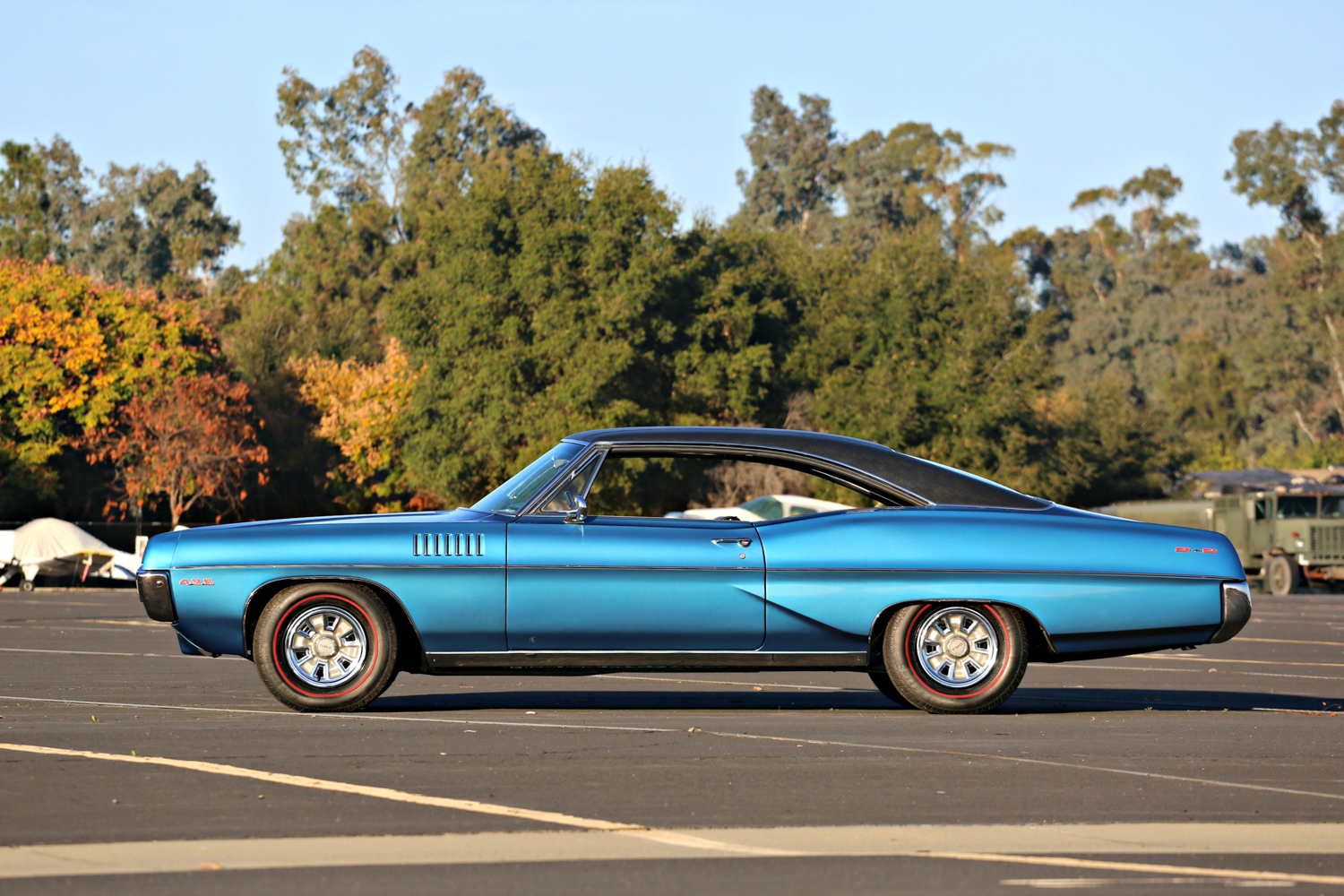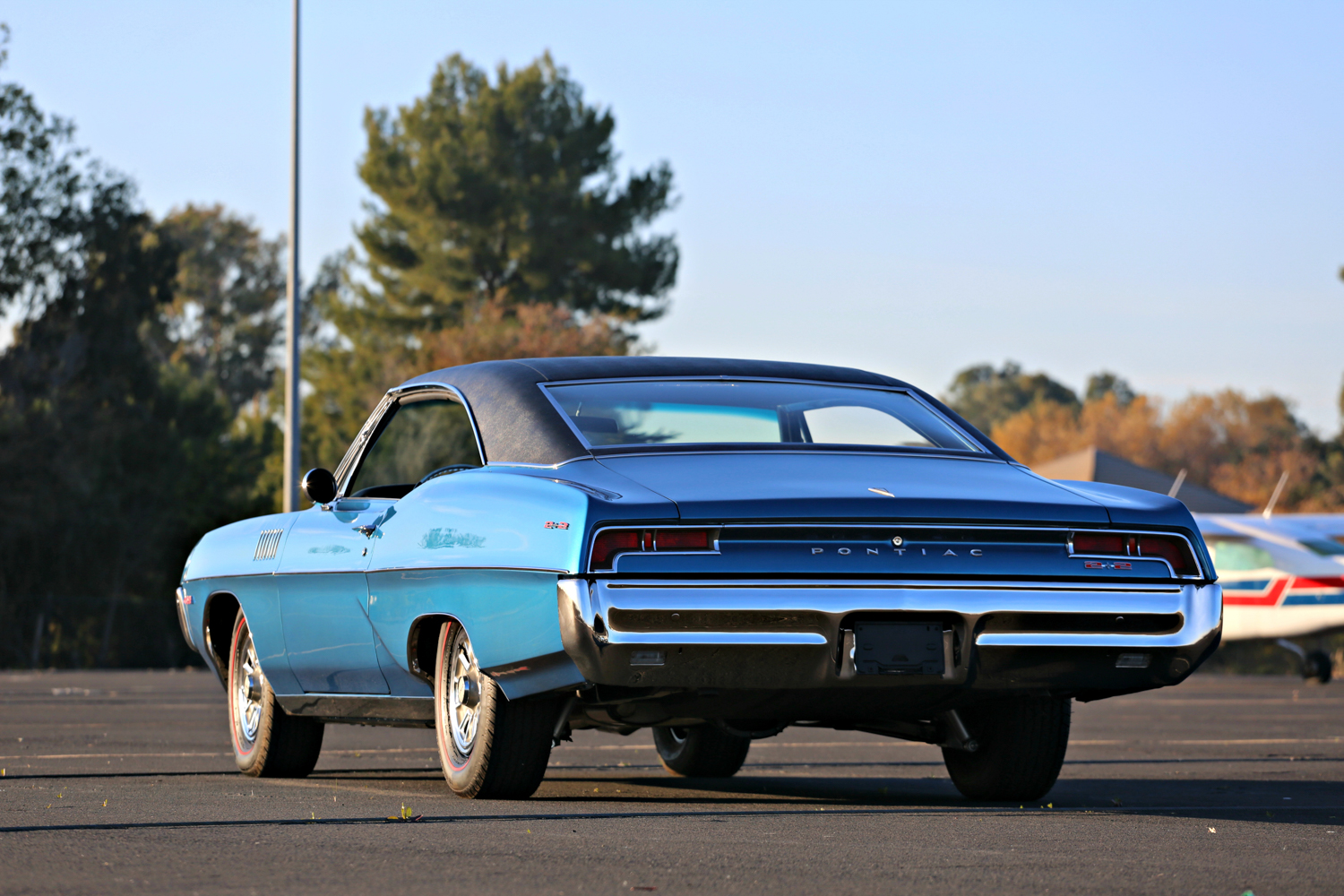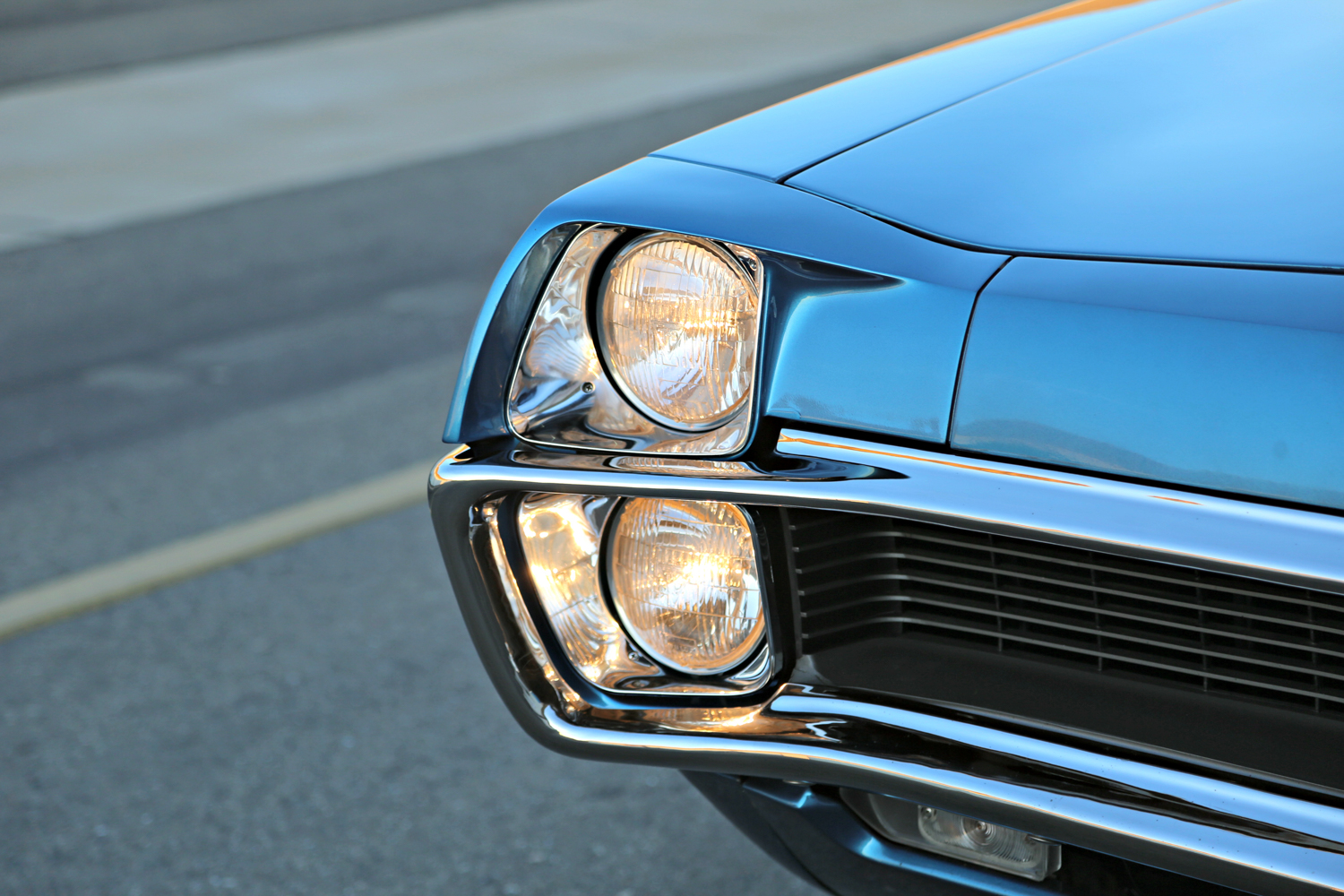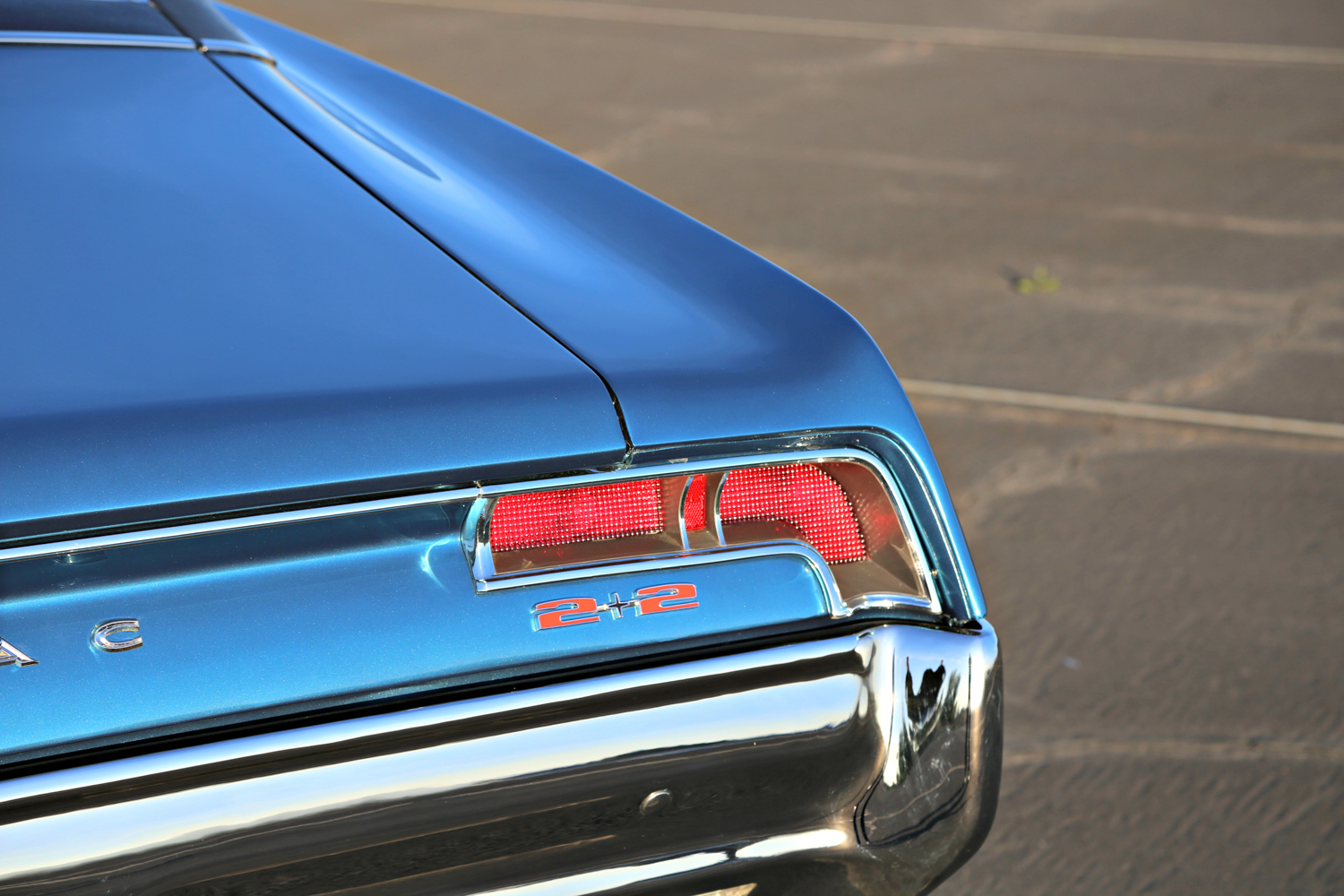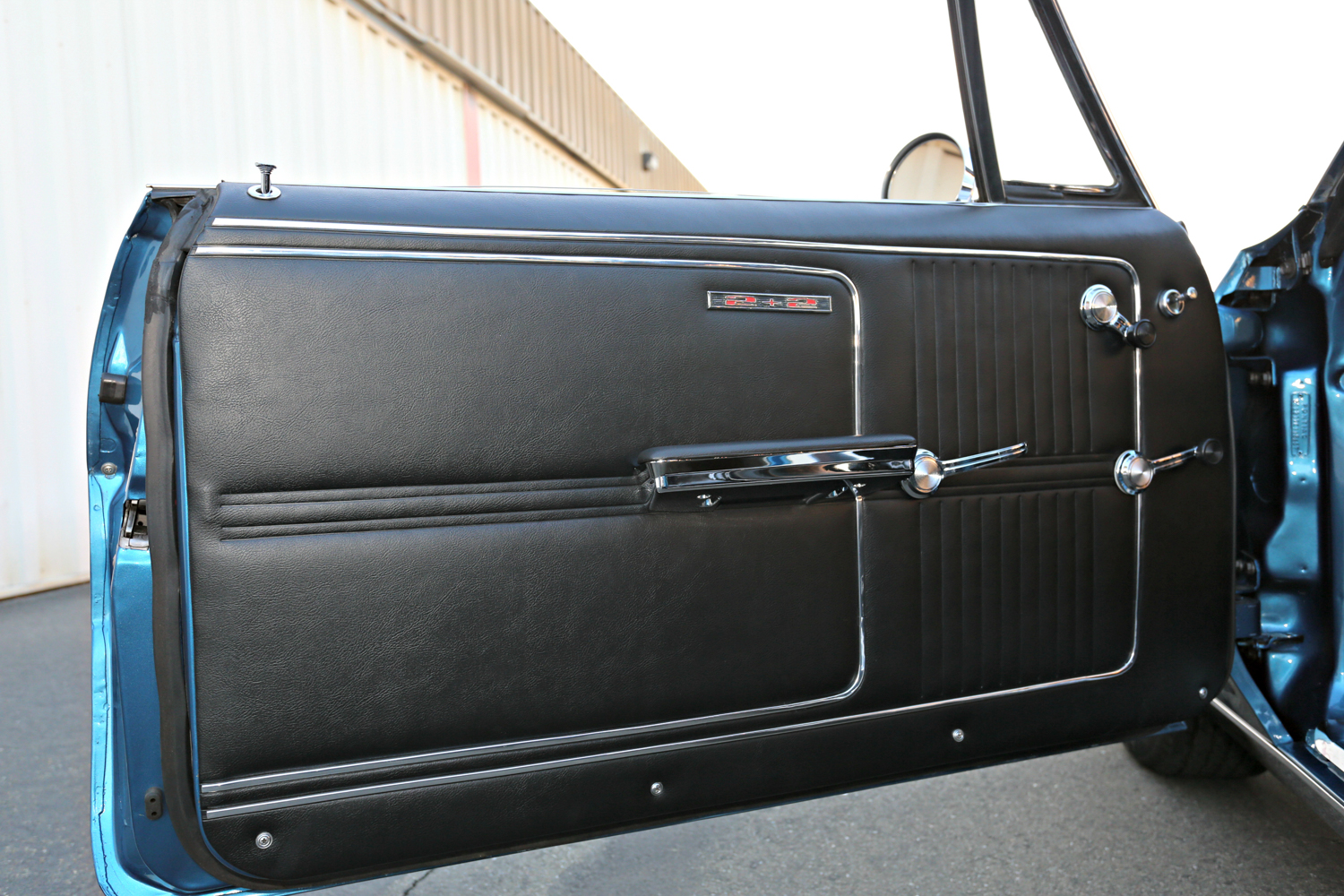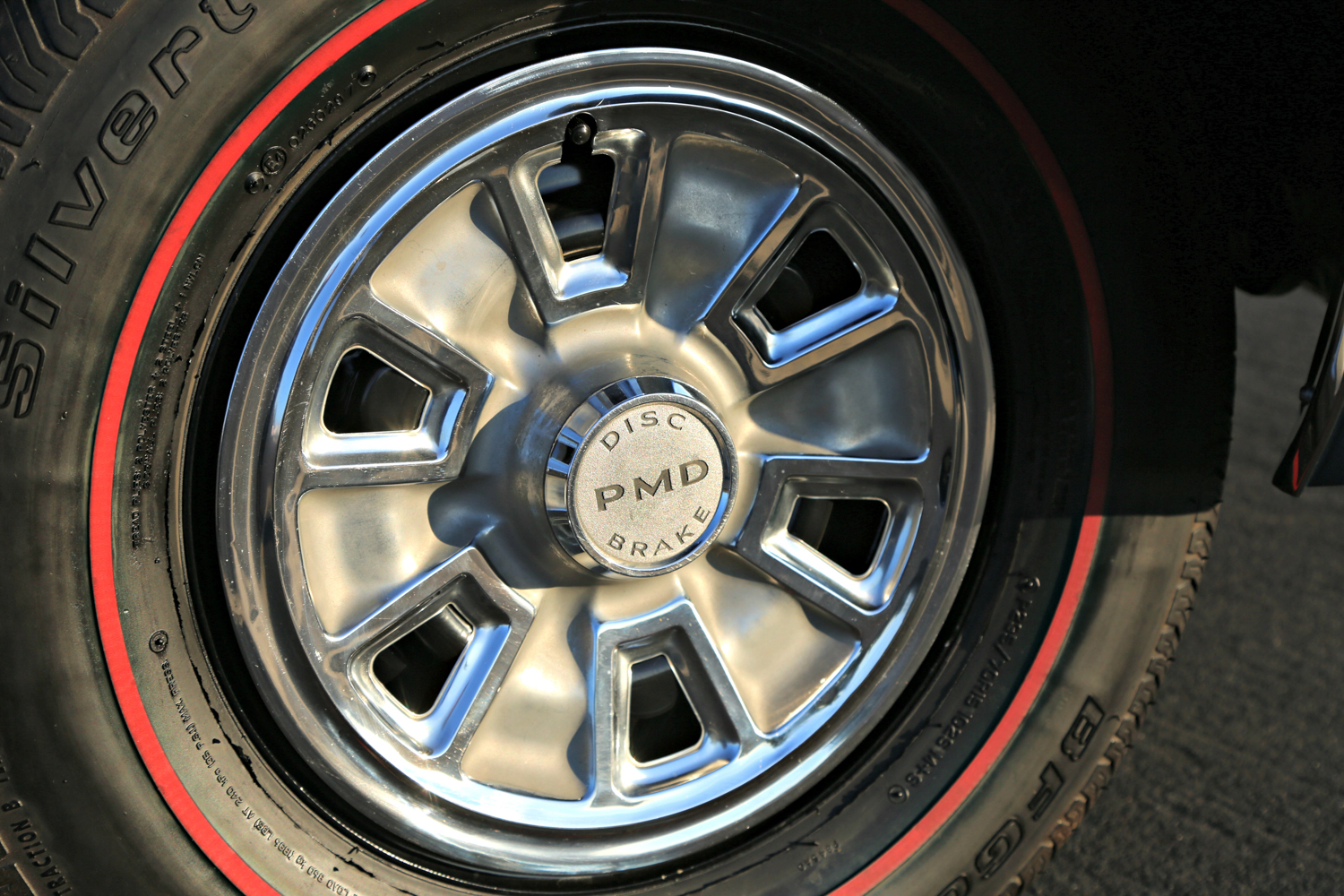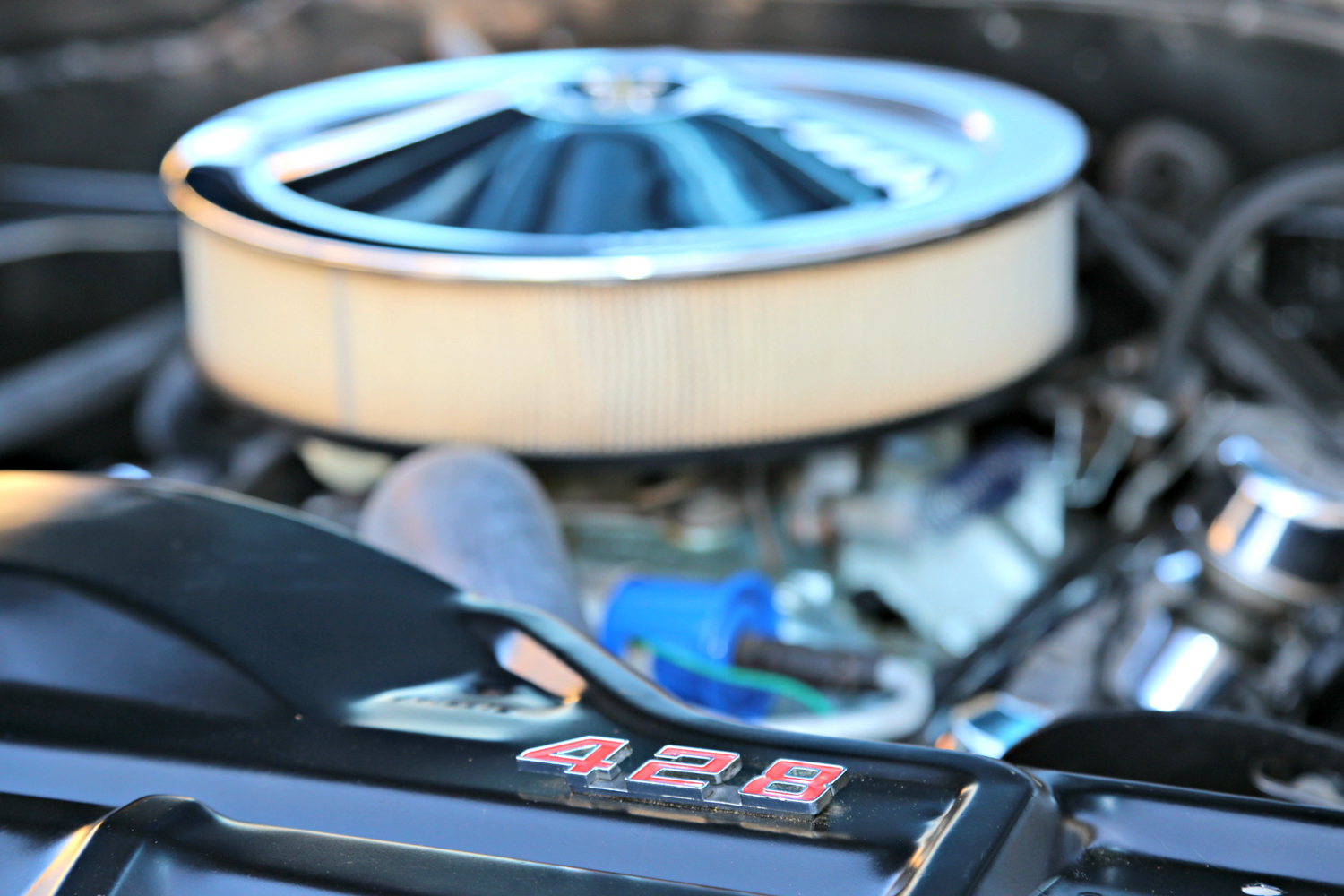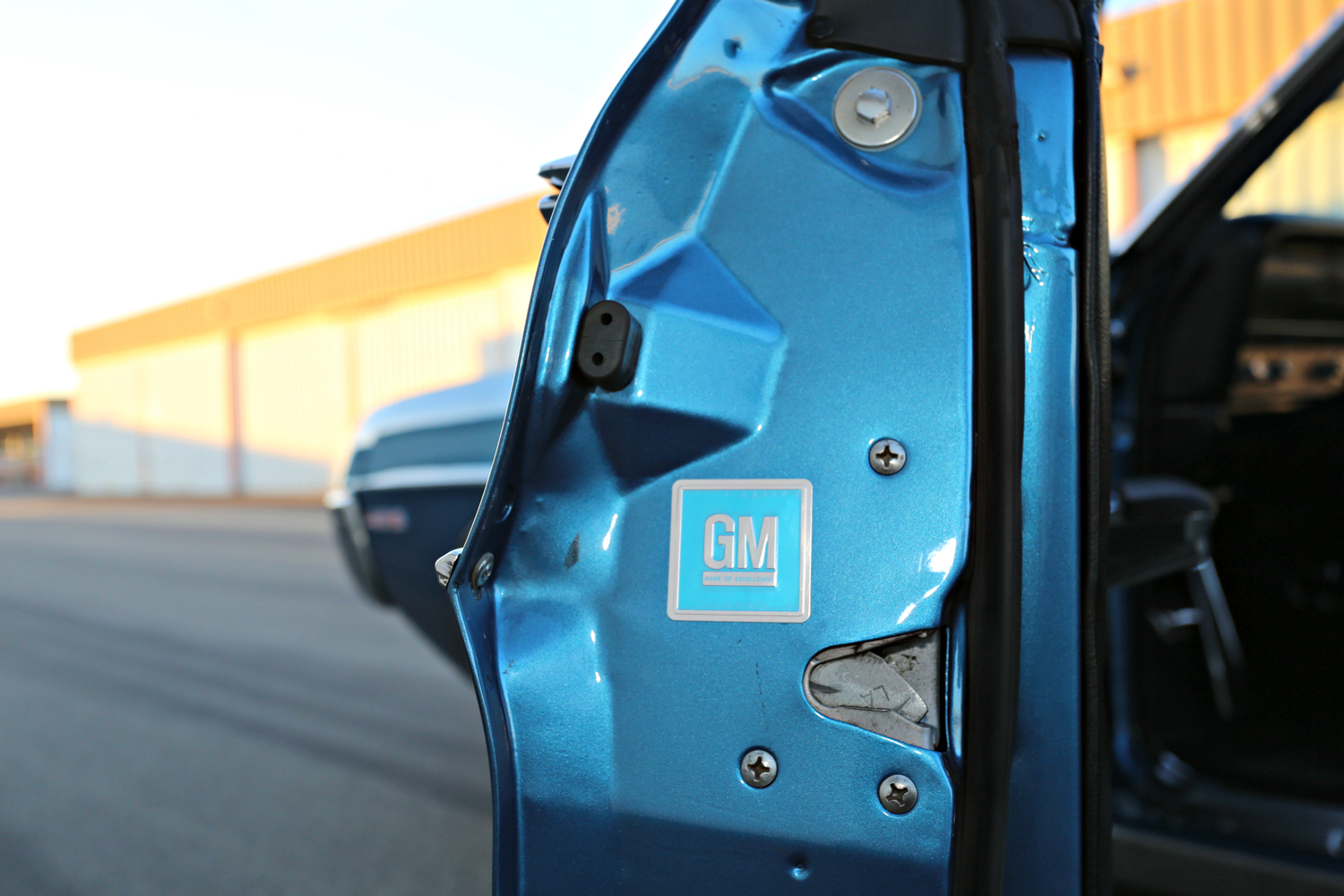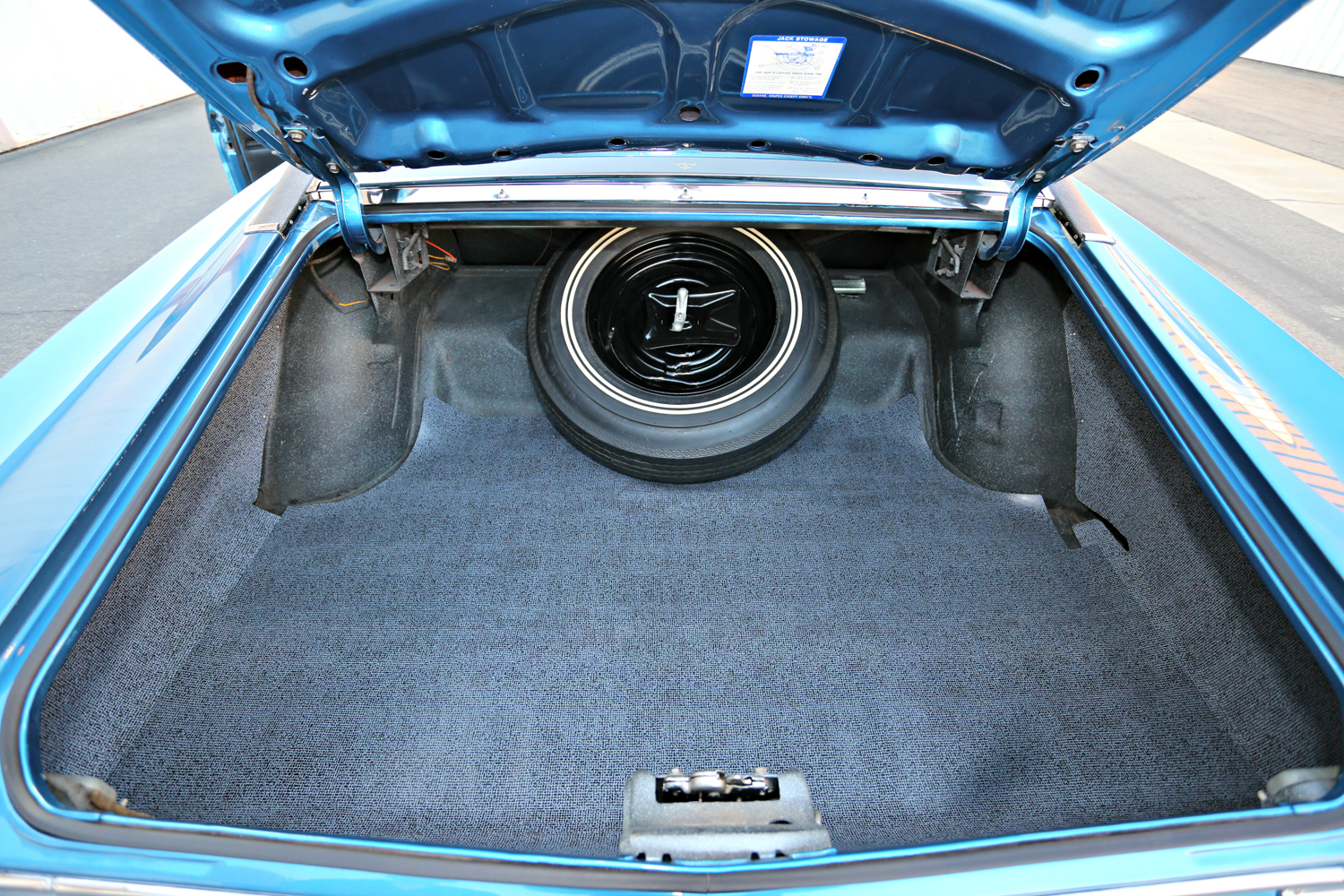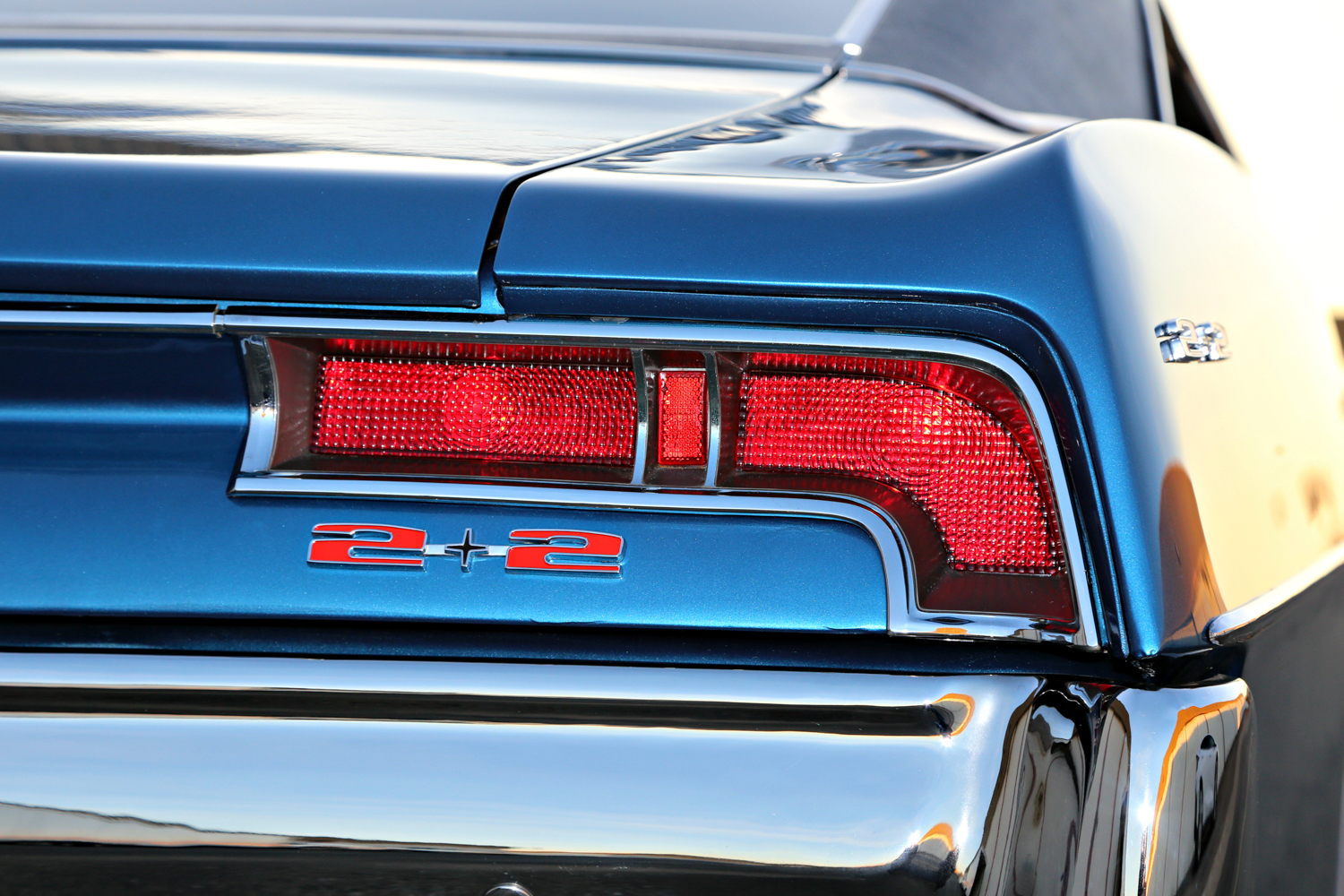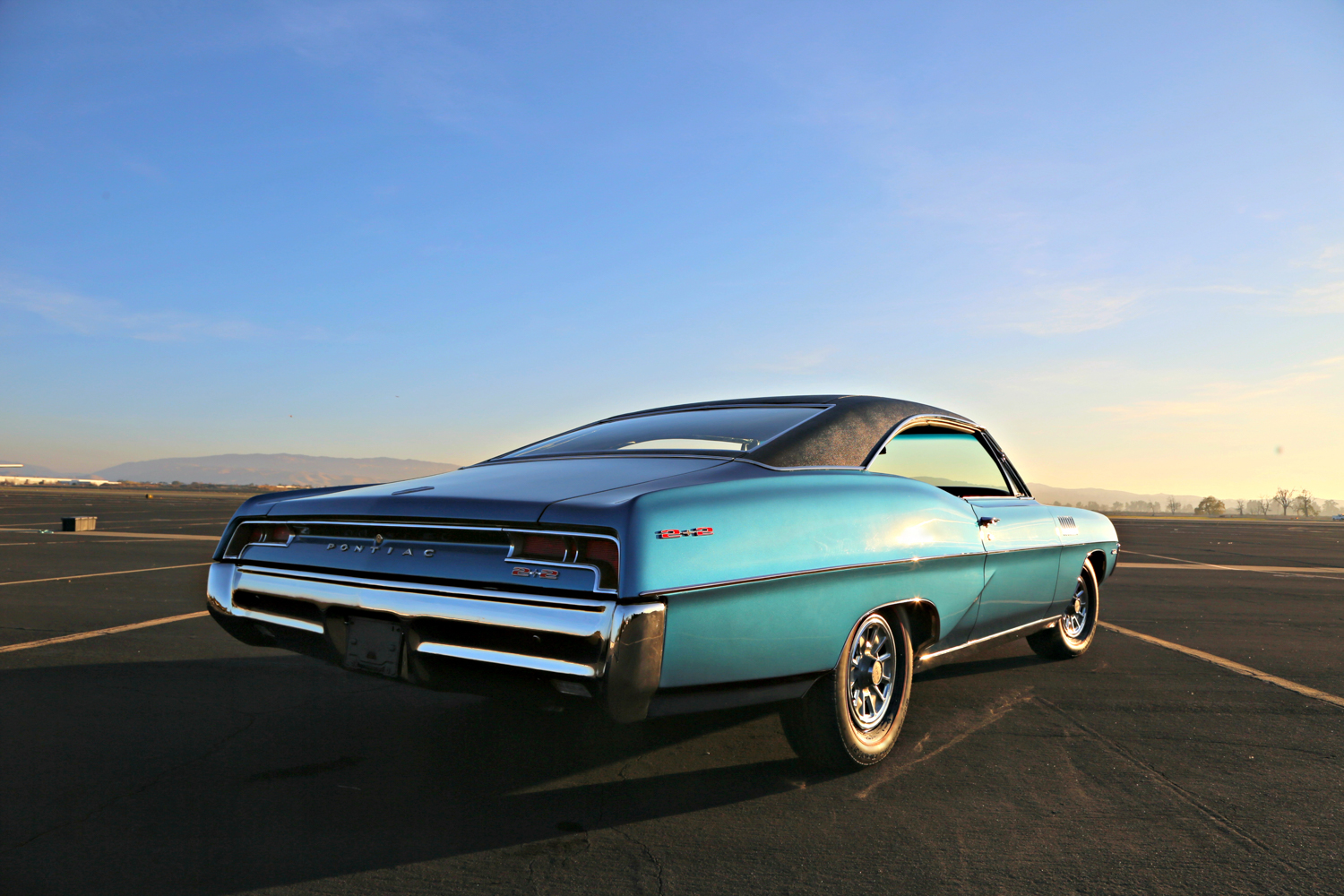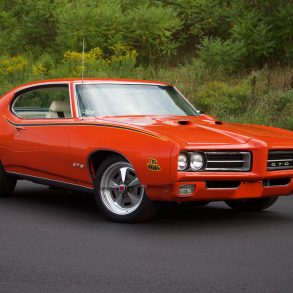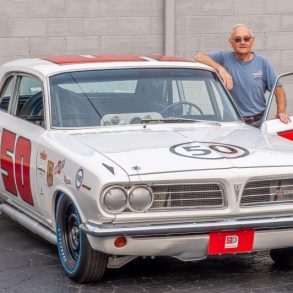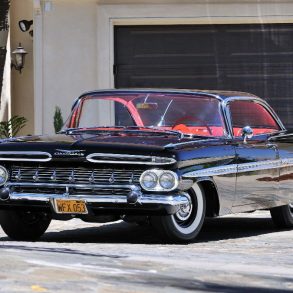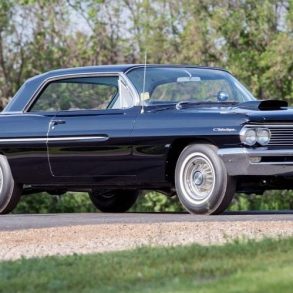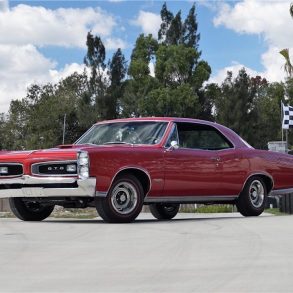
Offered in both a two-door hardtop and convertible, the 2+2 package was basically a Catalina with a bucket seat interior. You had to get up close to see the small 2+2 emblems on the fenders or deck lid to even identify it as such. Although it came standard with a 389-CI, 2-barrel engine, many where optioned with 421 engines, tri-power carburetion, 4-speeds and 8-lug wheels. It was a canvas on which to paint for those who wanted to create a big, fast performance car. Pontiac got more serious about the 2+2 in 1965, deleting the Catalina emblems from the car and including a 421 engine as standard equipment, plus a set of decorative gills on the fenders to set it apart from the regular Catalina. Emblems on the front fenders called out “421” to let everyone know this car meant business. The 1965 model received a lot of press when Car and Driver magazine tested a Royal Pontiac-prepped 2+2 against a V-12 Ferrari 2+2, out-performing it in almost every category, and creating controversy that still exists to this day.
https://www.youtube.com/watch?v=_cQ1ru65l14
In 1966, the 2+2 became a separate model from the Catalina, yet retained the same drive train package, plus the decorative gills were moved to the quarter panels. Sales for the 2+2 were never great, hitting a peak of 11,521 units for the 1965 model year. Its production numbers where dwarfed compared to the more popular GTO, and started to slip sharply after 1965. The handwriting was on the wall for full-size muscle cars like the 2+2, but Pontiac managed to produce it for one more year in 1967.
1967 ushered in fresh, new styling for all full-size GM cars, including Pontiac and the 2+2. A dramatic, sweeping roofline on the coupe was complemented by more restrained sculpturing down the sides of the car, featuring an angular flair that swept back into the quarter panel. Unique to the 2+2 model were the six decorative chrome shark gills embedded in the front fenders. Pontiac introduced retracting, concealed wiper arms in 1967, a feature that would not appear on most other GM cars until the following year. The front end of the car was most unusual. Although the stacked headlights were retained from the previous model year, the arrangement was unique thanks to a slim, split bumper assembly housing the grills and lower headlamps, with the upper headlights placed in a painted metal panel above the bumper. A painted valance panel below the bumper contained the parking lamps and served as a secondary air intake. The design moved Jan P. Norbye and Jim Dunne, authors of the 1979 book Pontiac: The Postwar Years to write, “ The 1967 front end remains the purest and most elegant ever used by Pontiac. It was the climax of its sequence, and the pinnacle of good taste.”
Another admirer of 1967 Pontiac styling is Northern California car collector Steve Marini. Marini and his team of restorers at GM Sports have restored many GM muscle cars, but big Pontiacs are among his personal favorites. GM Sports was a well-known wrecking yard and restoration shop that was located in San Jose, CA at the time, specializing in GM cars. The shop was moved to Stockton, CA a few years later, and is a still supplying rare parts and restoration services today. Marini has owned or worked on almost every GM performance car there is at one time or another. However, one car had always eluded him, a 1967 2+2 with the rare 428 H.O. engine.
“One day a customer walked into our shop looking for two 15” rims for his 1967 Pontiac, “ recalls Marini. “Almost all 1967 Pontiacs came with 14” rims, I told him, unless it was equipped with disc brakes. He said his car came from the factory with front disc brakes, so it had 15” wheels, which is a rare option. I had only seen disc brakes on a few station wagons, so I asked him if he had a wagon. That is when he said, with a smile on his face, that he had a 2+2 that he purchased new with 4-speed and a 428 H.O. engine.” This was not the first time someone told Marini they had a H.O. (High Output) car or a Super Duty car at home. After so many wild goose chases trying to purchase a real H.O. from someone, it almost always turned out to be a standard engine with chrome valve covers. Marini was skeptical. “Fortunately, I had some wheels for him and told him if he ever wanted to sell the car to let me know. If there is even a chance of it being an H.O., I have to check it out. You don’t know for sure unless you go look!”
A few weeks later the customer called and said he was going to sell the 2+2. Since the car was local, it was easy to go over and take a look. The car was sitting in a carport on the side of a house and had not run in years. It was solid, weathered, but totally original, including paint. Under the hood was the original 428 H.O., including all the right numbers and date codes. The engine had never been removed, and the whole car was untouched and unmodified. “The story was real this time,” said Marini. “We made a deal for the car and I was the proud owner of a ’67 2+2 that day.”
H.O., or High-Output Pontiacs are rare and coveted by collectors today. Expensive and built in limited numbers when new, the 428 H.O. was only produced from 1967 to 1969 (and the 1969 Grand Prix), and only available as an option in full-size Pontiacs. A 360-hp, 428 was standard in the 2+2, with the optional 376-hp High-Output, referred to as the “Quadra-Power” 428 in the factory performance sales catalog “The 376-hp Quadra-Power 428 is extra cost. Quadrajet 4-bbl. New heads. New combustion chamber design. Bigger intake and exhaust valves. New valve location. Enlarged ports. New intake manifold with smoother, more efficient runners. New free-flow header-type exhaust manifolds.” The famous Pontiac Tri-Power carbs were gone after 1966, due to a corporate decree banning multiple carburetion for all GM cars except the Corvette. The H.O. also featured a heavy-duty forged steel crank supported by 4-bolt main caps. A chrome, low-restriction air cleaner topped off the package.
After a close inspection and acquiring the verifying documents from Pontiac Historical Services, work began on Marini’s 2+2 in 2001. The car was completely dismantled and all parts cataloged for restoration. Every mechanical component was totally rebuilt to factory specs. The body had very little damage and almost no rust. Even the trunk floor was solid, normally an area subject to rust. The heavy vinyl trunk mats used by Pontiacs of the era trapped moisture and accelerated rust on the trunk floor. Fortunately, the original owner had removed the mat many years ago and spared this car from rust in the trunk. After the dismantling process, the body was put on a rotisserie and the frame and suspension components were sent to be stripped and powder-coated. The clear-rimmed steering wheel was sent to a specialist for restoration, as well as the door panels and dash pad. The correctly embossed seat material was located and sent to the upholstery shop. The bumpers were re-chromed and all the stainless-steel moldings and trim were polished out to a high luster. Customer cars would take first priority in the restoration shop, so work continued on and off for several years, during which time some NOS trim was acquired.
One of the rarest and most interesting options on the car is the front disc brake option. Pontiac already had better brakes than any other full-sized GM car with their famous optional, 8-lug wheel and finned aluminum drum set-up introduced in 1960. The 14” “8-lugs” as Pontiac enthusiasts refer to them today were very attractive, worked well and were popular with buyers. The disc-brake option necessitated 15” wheels and a special disc brake wheel cover, which were not as sporty looking as the 8-lugs or the newly available Rally II wheels. No other wheel or wheel-cover was available with disc brakes. All disc brake cars came power assisted with the new twin reservoir master cylinder arrangement.
Most H.O. cars were customer-ordered and this car was no exception. Along with disc brakes it was ordered with Tryol Blue paint, black vinyl top, H.O. engine, 4-speed transmission, Posi-traction rear end, Redline tires, as well as console and left-side remote mirror. Another rare option is the gauge package located inside the speedometer assembly. This car also does not have power steering, which is very rare on a full-size Pontiac from the ’60s. Four-speed High-Output cars are the most common big Pontiac seen without power-steering, ordered in this manner to save weight and gain power.
“We were fortunate to start with a very dry original car,” says Marini “Plus it was 100% complete and unmolested. Finding an unrestored muscle car that was never modified and has not beat to death by multiple owners is rare. I know from our parts business what other restorers are bringing back from the dead, with rusty bodies and missing hard to find parts. I’m so very lucky to get a hold of such a good original car to restore.” The result is a stunning car, with the Redline tires setting off the deep Tyrol blue paint and jet black top and interior. It looks mean and fast, and it is.
High Performance Cars magazine tested a 1967 428 H.O., 4-speed 2+2 coupe, along with a GTO and the new Firebird in an article entitled “Pontiac Performance Party” for their September 1967 issue. As with the 1965 Car and Driver report, a team from Royal Pontiac tuned each car to squeeze as much power as possible. Fitted with a set of 8.50 x 14 M&H cheater slicks and a 4:11 Posi rear end, the big Pontiac stormed through the quarter-mile in a blistering 13.37 seconds at 106.01 mph. This beat the 13.72 ET at 100.4 mph recorded in the 1965 test. Impressive for a huge car that weighed 4,080 pounds as tested!
Great looks and exceptional performance were not enough to save the 2+2 from being un-ceremoniously dropped from the Pontiac line-up after 1967. Not only did the big car have the GTO to compete with, but also the new for 1967 Firebird was vying for performance seeking customers at Pontiac showrooms, as well. The 2+2 would still be available (with Chevy power) to Canadian buyers until 1970. Chevrolet would cease to produce the Impala SS after the 1969 model year, and the Ford Galaxie XL would be gone after 1970. The era of the full-size performance car had come to an end.
Pontiac produced just 1,768 2+2 models for 1967 (including 280 convertibles). According to the GM Heritage Center, only 261 customers opted for the H.O., and only 144 H.O. cars came equipped with a 4-speed transmission. All of these numbers add up to a very rare Pontiac today.
Driving one of these cars is as fun as it looks. Owners of full-size, Wide Track Pontiacs will tell you their cars will out handle a GTO on a windy road. With its wide stance and ample power, the big Pontiac feels tight and responsive. When pushed hard, it tracks well and lets you know where you are in a turn. The Muncie M-20 wide-ratio transmission is familiar and feels great running through the gears at a rapid pace. There is enough torque to start in second and skip to fourth gear, if you wish, around town, but with this kind of power, shifting is more fun. With the 3:42 rear end, the 2+2 is fast off the line, but still good on the highway. It is always cool to be cruising at 60 mph, downshift, and be gone. The sound of fresh air being sucked into the open-element air-cleaner and exiting melodically through the dual exhaust pipes while being pinned back into the seat is what muscle car fans live for. Yes, this car is a blast to drive.
At the time of this writing, this Pontiac has hardly been driven since its restoration was completed, and small adjustments are still being made, but there are plans to display the car. “A lot of people don’t realize they even made a 2+2 in 1967, and if they do, they have never seen one. It should be fun to show this car off in public. I can’t wait. But the real enjoyment is going to be driving it. Nothing drives like a big Pontiac with really big motor and a 4-speed,” says Marini. After spending some time with this machine, I have to agree.
1967 Pontiac 2+2 Specifications
| Engine | 428 cubic inch V-8, “Quatra-Power” |
| Compression | 10.75:1 compression ratio |
| Carburetion | Single Rochester 4-bl |
| Horsepower | 376 hp at 5100 rpm |
| Torque | 462 lb-ft Torque |
| Transmission | 4-speed manual, all-synchromesh, Muncie M-20, Hurst shifter |
| Rear End | Safe-T-Track 3:42 limited slip |
| Suspension | Independent front, live rear axle rear |
| Steering | Manual, reticulating ball |
| Brakes | Power assisted. Front wheel disc, rear drum |
| Wheels | 15” steel wheels with special disc-brake only full wheel covers |
| Weight | 3860 lbs |
| Wheelbase | 121 in. |
| Length | 215.1in |




